Apologies: Site was down: more ram added, okay now
 Once again apologies to authors and comment writers for the loss of their work. Due largely to a continuous increase in visitors to the site, the v-server could not keep up and had to be upgraded. Just under a week ago we ran into problems and lost two days worth of articles, taking us back to the 14th of December. We replaced those articles and put new ones up, only to lose all the same ones in this more serious outage.
Once again apologies to authors and comment writers for the loss of their work. Due largely to a continuous increase in visitors to the site, the v-server could not keep up and had to be upgraded. Just under a week ago we ran into problems and lost two days worth of articles, taking us back to the 14th of December. We replaced those articles and put new ones up, only to lose all the same ones in this more serious outage.

We have spent a lot of anxious time monitoring what was happening and trying to deal with it, as well as doing the usual seasonal stuff. We were too bushed to put up a notice when early in the morning today, the problems were fixed. We hope people will help us to plug the gaps.
Because a continuous rise in readers had overstretched the RAM in the virtual machine that candobetter lives on, we have now upgraded to a more expensive gutsier server, so hopefully we won't have another outage like that soon.
Seasons Greetings!
Topic:
Sandra Kanck on Australian Democrats growth-lobby backlash
 Sandra Kanck gives her account of what preceded her 'expulsion' from the Australian Democrats over the matter of population policy. Sandra was an Australian Democrats member of the South Australian Legislative Council from 1993-2009 and the last Democrat member in elected government. When she retired she became the president of Sustainable Population Australia (SPA) and still is. The conflict in the Australian Democrats is a reflection of the greater conflict in Australia between the growth lobby and democratic representation and environmental democracy. As such it is important to people far beyond the Democrats themselves. (Article written by Sandra Kanck).
Sandra Kanck gives her account of what preceded her 'expulsion' from the Australian Democrats over the matter of population policy. Sandra was an Australian Democrats member of the South Australian Legislative Council from 1993-2009 and the last Democrat member in elected government. When she retired she became the president of Sustainable Population Australia (SPA) and still is. The conflict in the Australian Democrats is a reflection of the greater conflict in Australia between the growth lobby and democratic representation and environmental democracy. As such it is important to people far beyond the Democrats themselves. (Article written by Sandra Kanck).

The observations already made on “Can Do Better” about what has happened in relation to the internal machinations of the Democrats and my sacking from the party are extremely perceptive. That’s probably because those of us who have fought for population abatement have seen these things acted out before, sometimes on bigger stages and not necessarily in political parties.
Thirty-three years ago, in formulating the Democrats’s no.2 objective “To accept the challenges of the predicament of humanity on the planet with its exponentially increasing population, disappearing finite resources and accelerating deterioration of the environment”, the founding mothers and fathers of the party were profoundly aware of the future.
The treatment meted out to me began, I suspect, a year ago when a strongly-worded new draft population policy was circulated – and I was a member of that policy working group. The pressure mounted when it went out to ballot in May, and further increased when the ballot was supported by 80% of those members voting. As voting is voluntary, it was a clear victory because those who strongly opposed it would have ensured they cast their votes.
But around the time of the circulation of the draft policy, I was approached by South Australian-based political party, Stop Population Growth Now (SPGN), and asked if I would find out if a letter from them might be published in the Democrats’ National Journal – that letter suggested the amalgamation of SPGN with the Democrats to strengthen our common base and form a new political party. I took this to the party’s National Executive and it was voted down. But, combined with the policy ballot, it seems it was the beginning of the end for me.
I was obviously never privy to the background plotting that led to a vote by the party’s National Executive just five weeks ago to declare Sustainable Population Australia Inc., of which I am National President, to be a political party - and it came as a complete surprise to me. The losers in the policy ballot had set things up for a swift counter-offensive. Payback was in order for the strong policy ballot result it seems – and big time!
The spokesperson who advised the media on Tuesday that I had been expelled, John Davey, is also the factional leader and puppet-master of the group which has taken this action. The conflict of interest between his means of earning an income, that of a migration agent, and working to take me down because of my determination to give primacy to the environment ahead of economic self-interest, seems not to have been recognised by his supporters and never acknowledged by him.
As a Democrat member said to me “this debacle has revealed itself for what it is - a fight between the growth-at-any-cost group and those who care about the future of our country and the world”. It’s a fight that is writ large elsewhere, a fight that will ultimately be lost by the growthists when the planet itself hits back. As the saying goes “Nature bats last”.
Sustainable Population Australia (SPA) not a political party
 The environmental group at the centre of the controversy between its national president, Hon. Sandra Kanck, and the Australian Democrats has countered claims by those who expelled Ms Kanck that it is a political party.
The environmental group at the centre of the controversy between its national president, Hon. Sandra Kanck, and the Australian Democrats has countered claims by those who expelled Ms Kanck that it is a political party.
Spokesperson for Sustainable Population Australia (SPA), Dr Jane O’Sullivan, says that SPA is recognised by the Dept of Environment (SEWPAC) as an environmental group, a prerequisite for obtaining tax deductible status through the Australian Tax Office. The regulations governing this are strict and include one that precludes any association with a political party, let alone running candidates for office as a party.
“For its 24 year history, SPA has had a mix of members from all walks of life and from all political parties. These include Labor, Liberal, National, Greens, Australian Democrats, Stable Population Party and the Stop Population Growth Party,” says Dr O’Sullivan.
“SPA is very mindful of being independent of political parties,” she says. “We are a lobby group that seeks to inform the public and policymakers of the need for an ecologically sustainable population.
“Because an ecologically sustainable population is less than the one we have at current standards of living, SPA calls for an end to population growth through lower migration and birth rates.
“It thus comes as no surprise that the leader of the coup against Ms Kanck, John Davey, is a migration agent who clearly has a vested interest in either maintaining or increasing migration levels,” says Dr O’Sullivan. “That is what this dispute is really all about.”
Dr O’Sullivan says that the national executive of SPA acknowledges the huge amount of work Ms Kanck undertook in trying to keep the Australian Democrats viable.
“This has, however, been entirely separate from the work she has done for over three years in running our organisation,” she says.
Australian Democrats' new population policy caused minority dummy-spit?
 Policy Objective: a) To ensure our continent’s long-term sustainability, we aim to first stabilise then reduce Australia’s population to an ecologically sustainable level... Inside read the Democrats' new population policy for Australia and a comment from the Senior Deputy National President, Darren Churchill.
Policy Objective: a) To ensure our continent’s long-term sustainability, we aim to first stabilise then reduce Australia’s population to an ecologically sustainable level... Inside read the Democrats' new population policy for Australia and a comment from the Senior Deputy National President, Darren Churchill.
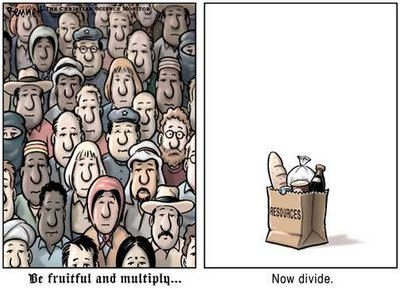
In response to my article, "Growth lobby finally devours Australian Democrats?" here: Darren Churchill, Senior Deputy National President, Australian Democrats, wrote: "Your article asks, "Whatever happened to the Democrats' Population Policy?" Well, after some years without a proper population policy (although population was still referred to in our Immigration and Environment Policies and our party objectives) the Australian Democrats balloted a new Population Policy in May this year. it has been hailed by many as our "best Population Policy ever!" See it here: http://www.democrats.org.au/policies/pdf/Population.pdf."
I'll allow your readers to make their own assessment of the connection of our strongly balloted policy and the stories of the last couple of days."
Here it is below, to save readers looking up the pdf:
Australian Democrats Population Policy
THE ISSUE
1. As a consequence of human impacts, Australia faces serious environmental degradation and resource constraints which continue to be exacerbated by a growing population, increased per capita consumption and inefficiencies.
2. Population growth reduces our ability to preserve our unique biodiversity and places strains on our economy, infrastructure and housing supply.
3. A growing population puts more pressure on us to find new ways of ‘keeping up’ with material demands that are one of the highest per capita in the world.
4. Population growth does not necessarily create wealth, despite the claims of the development lobby, and it certainly does not improve national well-being.
POLICY OBJECTIVES
a) To ensure our continent’s long-term sustainability, we aim to first stabilise then reduce Australia’s population to an ecologically sustainable level.
b) To restrain population growth in a way that is equitable to all, is in keeping with the environment’s capacity to sustain human numbers and that acknowledges Australia’s international human rights obligations.
c) To support families in making decisions about family size so that additional stresses are not placed on our unique environment, long-term agricultural productivity or infrastructure.
POLICY ELEMENTS
The Australian Democrats will work towards:
i. Creating a formalised system whereby immigration intakes are determined as a result of trends in key indicators of sustainability.
ii. Decoupling the business visa class immigration programme from market demand, and instead introducing an annual quota system congruent with key indicators of sustainability (when considered with Policy Element iii).
iii. Doubling the numbers in our humanitarian visa class.
iv. Expanding programmes promoting gender equality, empowerment and opportunities for women, and welfare services so that the aged are less reliant on their dependents to financially support them, both at home and in our international development programmes.
v. Expanding programmes that make all family planning options cheaper and more accessible to anyone who may choose them.
vi. Expanding programmes that provide retraining and support the 1.5 million long-term underemployed, unemployed and disadvantaged back into the workforce.
vii. Limiting baby bonus/family leave provisions and diverting the resources to education, family planning and foreign aid.
Official Australian Democrats Policy – as balloted 25 May 2012
Humanity ? Sustainability ? Prosperity ? Democracy Page 1 of 1
Authorised by: Darren Churchill, 29 Brunswick Circuit, Kaleen, ACT, 2617
Population growth drives electricity prices up - Kelvin Thomson
 Kelvin Thomson MP: "It seems to me that a key driver of rising electricity prices that doesn’t get much attention in the electricity prices debate is population growth. This growth was driving electricity prices up at twice the rate of CPI long before the carbon price ever showed up. I did a detailed speech in Parliament in late 2010 about this issue, which pointed out that electricity prices in Sydney and Melbourne had doubled in the previous decade, which was twice the rate of CPI."
Kelvin Thomson MP: "It seems to me that a key driver of rising electricity prices that doesn’t get much attention in the electricity prices debate is population growth. This growth was driving electricity prices up at twice the rate of CPI long before the carbon price ever showed up. I did a detailed speech in Parliament in late 2010 about this issue, which pointed out that electricity prices in Sydney and Melbourne had doubled in the previous decade, which was twice the rate of CPI."

Population a key driver of Electricity Prices
[Originally published at http://kelvinthomson.blogspot.com.au/2012/12/electricity-prices.html Headings are by candobetter.net editor]
It seems to me that a key driver of rising electricity prices that doesn’t get much attention in the electricity prices debate is population growth. This growth was driving electricity prices up at twice the rate of CPI long before the carbon price ever showed up. I did a detailed speech in Parliament in late 2010 about this issue, which pointed out that electricity prices in Sydney and Melbourne had doubled in the previous decade, which was twice the rate of CPI.
Poor understanding of impact of population growth on infrastructure among policy makers
The impact of population growth on the cost of infrastructure isn’t well understood, not even by policy makers. If the average life of the nation’s infrastructure is 50 years, then you’ve got to set aside 2% of the nation’s income every year to keep replacing it and deal with it wearing out. But if your population is increasing by 2% a year then the new people need 100% extra infrastructure for their needs, so you’ve got to set aside another 2% of the nation’s income for that, that is, twice as much as with a stable population.
A 2% population increase only gets you 2% extra income, but it doubles your infrastructure spend. That’s why electricity, gas, water, council rates all keep rising higher than inflation. I don’t think it’s fair that pensioners and ordinary consumers should have to pay for this. I think that it’s the beneficiaries of population growth who should pay for the costs of it. The principal beneficiaries are the property developers whose land values rise when population rises.
Classic example where developers should pay to change zones
A classic example was reported in Melbourne a couple of days ago of property developers wanting to build 30 storey high-rise buildings at Fisherman’s Bend. These developments inevitably require more electricity infrastructure – I don’t think pensioners in my electorate and other inner city residents should have to pay for that. I think that when they put in an application for rezoning or planning permits that mean more people are going to live on the site, there should be a financial contribution that genuinely reflects the extra infrastructure costs that come with that population growth. The mechanism for that needs to be worked out between governments, electricity companies and Councils, but the principle should be that the beneficiaries of population growth pay for the extra infrastructure costs that come with it.
Growth lobby finally devours Australian Democrats?
 On 11/12/2012 newspapers reported that Sandra Kanck, last Australian Democrat to leave parliament, now president of Sustainable Population Australia, had been 'expelled' from the Democrats by John Davey, a professional migration agent, in the role of "Democrats National Executive spokesman." Davey is reported to have said that "the decision was made as a "last resort" after Ms Kanck refused 'repeated requests to put appropriate distance between her activities amongst other special interest groups and the Democrats'". Senior Deputy National President Darren Churchill defended Kanck, saying that a group of seven people had attempted to take control of the party and was "removing anyone who stands up to them". It seems incredible, but is this also the same John Davey of the Democrats whom in 2002 Crikey.com referred to as a "former porn lobbyist" and "Director of the Eros Foundation, the lobbying group for various naughty interests" in "The power behind Brian Greig’s throne [in the Australian Democrats]"?
On 11/12/2012 newspapers reported that Sandra Kanck, last Australian Democrat to leave parliament, now president of Sustainable Population Australia, had been 'expelled' from the Democrats by John Davey, a professional migration agent, in the role of "Democrats National Executive spokesman." Davey is reported to have said that "the decision was made as a "last resort" after Ms Kanck refused 'repeated requests to put appropriate distance between her activities amongst other special interest groups and the Democrats'". Senior Deputy National President Darren Churchill defended Kanck, saying that a group of seven people had attempted to take control of the party and was "removing anyone who stands up to them". It seems incredible, but is this also the same John Davey of the Democrats whom in 2002 Crikey.com referred to as a "former porn lobbyist" and "Director of the Eros Foundation, the lobbying group for various naughty interests" in "The power behind Brian Greig’s throne [in the Australian Democrats]"?

Whatever happened to the Democrats' Population Policy?
The Australian Democrats used to have a population policy in favour of a small population in Australia for ecological reasons. Under Democrat John Coulter's presidency a bitter battle was fought to preserve this position. Tension developed as immigrationist members gained some traction through fair and foul means and continually tried to break up the policy, purportedly wearing down the mainstream membership.
Cheryl Kernot
During Cheryl Kernot's leadership, the profile of the party became so strong that it looked to some as if Cheryl might actually eventually become prime minister. At the same time she began to downplay the population policy. Then, to the shock of many Australians, overnight Kernot left her own party and joined the ALP. It seemed to some as if she for some reason failed to take seriously her own success and had been seduced by inaccurate promises of a stronger rise to power via the ALP. Instead she fell into almost total obscurity, and it looked to many as if she had been pushed.
Gradually the Party seemed to be pulled apart, finishing up with Andrew Bartlett, an immigrationist at its head. It was now hardly recognisable as itself and hardly registered on the voting radar. Bartlett was also an extreme advocate for non-detention of asylum seekers. Losing his Queensland seat in the last Federal election, Bartlett ran in the 2009 election for the [immigrationist] Greens. Not succeeding there, he became a research fellow in Migration Law at the College of Law, Australian National University.
Sandra Kanck
Sandra Kanck was an Australian Democrats member of the South Australian Legislative Council from 1993-2009, after which she became president of Sustainable Population Australia, a group that wants a small population for Australia. Australia in the grip of a population growth lobby with extremely high immigration and awards bonuses to women who have babies. Kanck is also involved in numerous other causes.
Countering John Davey's claim to authority in the Democrats is Darren Churchill, who holds the title of Senior Deputy National President of the Democrats. He says that Ms Kanck has not been expelled at all and that Mr Davey does not have the power to expell her. Churchill reportedly said a group of seven people had attempted to take control of the party and was "removing anyone who stands up to them".
"...Mr Churchill said the group headed by Mr Davey had proclaimed itself to be running the Democrats and had set about passing a series of unconstitutional motions to expel or suspend anyone who did not fit into their agenda." ..."(Mr) Davey is not a spokesperson for the party - he has not been approved by our proper procedures and processes."
Deputy National President, Darren Churchill has said that the "only constitutionally authorised person to speak to the media on national executive matters is the national president." According to him there is an upcoming election for a new president, and, until someone is elected in that role, the Deputy National President has assumed the role of party spokesman. (Source: http://www.dailytelegraph.com.au/news/breaking-news/kanck-still-a-democrat-party-official/story-e6freuz0-1226534655857)
In a story taken from Adelaide Now Mr Davey was reported in the Australian to have said:
"The most important principle we hold as Australian Democrats is to be beholden to no group or groups in the community."
Mr Davey himself is the Principal Solicitor and Registered Migration Agent for Hermes Legal and Migration Services, which also advertises that it has a network of professional teachers and tutors who can assist in the preparation for the International English Language Testing System (“IELTS”) and that it is currently taking enrollments for classes in Adelaide, Melbourne and Canberra. "Class sizes are limited to 10 and pre-booking is essential. Classes last for 3.5 hours (with a 20 minute break in between) and cost $77.00 each inclusive of GST." http://www.hermlegal.com.au/index.php/our-services
Below are some more details:
" Herm Legal and Migration Services:
John Davey
John Davey BA (Melb), LLB (Syd), GCLP (UniSA)
Principal SolicitorJohn is the Principal Solicitor and Registered Migration Agent of our firm. He has extensive experience in both the public and private sectors and was a one time legal adviser to the Australian Democrats in the Commonwealth Senate. Admitted to legal practice in South Australia, Victoria, the Australian Capital Territory and the High Court of Australia. John also teaches in the Migration Law Program at the Australian National University and is the attending solicitor at the Aids Action Council in Canberra. John’s expertise lies in commercial migration and dispute resolution law and maintains an active part in community activities. John holds a Bachelor of Laws from the University of Sydney, a Bachelor of Arts from the University of Melbourne and a Graduate Certificate in Legal Practice from the University of South Australia and is registered as a Migration Agent with the Commonwealth Office of Migration Agents Registration Authority (Migration Agents Registration Number: 0851129)."
Massive accrual of power on all fronts by Growth Lobby in Australia
Australian political parties have been stalked by the commercial population growth lobby now for years. (See Sheila Newman The Growth Lobby and its absence in Australia and France, Chapter 6, for the history: http://candobetter.wikispaces.com/file/view/GrowthLobbyAndAbsence-Newman-2002.pdf (wikispace deactivated -have asked to reactivate - Ed, 21 Oct 14) and http://adt.lib.swin.edu.au/public/adt-VSWT20060710.144805/index.html.) There are many examples of the devastating effect this march has had on our democracy. (See http://candobetter.net/GrowthLobby.) This process has contaminated the mainstream media as well as the commercial media, and it seems to have utterly infected the Australian Labor Party and the Liberals in every State. The Greens also seem to have been fatally weakened by it, and the Australian Democrats continue to be torn apart by it. The power of the Australian Multicultural Foundation, working with the Australian Academy of Technical Sciences and Engineering (ATSE), the Scanlon Foundation (formerly the Brencorp Foundation) and the Institute of Global Movements is quite frightening (see: http://candobetter.net/node/1928 ) as is the power, financial and media reach [See http://candobetter.net/taxonomy/term/705 and http://candobetter.net/taxonomy/term/249 ] of the Property Council of Australia and APop.
Read about a new population theory in Demography, Territory & Law: The Rules of Animal and Human Populations (see link). Forensic biologist, Hans Brunner writes of it: "This book takes us to a completely new paradigm in multiple species population science. It shows how little we understand, and how much we need to know, of the sexual reactions when closed colonies with an orderly reproduction system are destroyed, be it people or animals." Two chapters are on multi-species demography, the rest apply the theory to non-industrial societies and the author comes up with a completely new test for the collapse model of Easter Island, which will stun those who thought they knew all about it.
Nature to humankind: I think we really need to talk about our relationship
 You may think that “austerity” is a hoax. A conspiracy of bankers and CEOs and neo-liberals to rob of us our rightful entitlements. But you obviously haven’t heard the news. This is not the 1930s. This austerity is not contrived. This austerity is for real. This austerity is geologically, not ideologically rooted. There is not enough real wealth to go around.
You may think that “austerity” is a hoax. A conspiracy of bankers and CEOs and neo-liberals to rob of us our rightful entitlements. But you obviously haven’t heard the news. This is not the 1930s. This austerity is not contrived. This austerity is for real. This austerity is geologically, not ideologically rooted. There is not enough real wealth to go around.

Mother Nature and Mankind: A Communication Breakdown
The relationship that counts
Perhaps you forgot about me.
No wonder. Your history books seem to dwell on tyrants and dictators and megalomaniacs and the
terrible things they do.
Yet I can do terrible things too. Especially when I am taken for granted or abused.
I know. I never commanded an army or ruled a nation.
I never sent 13 million people to the gas chambers or starved and murdered six million Ukrainians.
I never firebombed Hamburg, Dresden or Tokyo, nor dropped two atomic bombs.
I never raped Nanking or slaughtered a third of Cambodia’s population.
I never conducted a war of ethnic cleansing nor destroyed a culture and enslaved the survivors.
I never committed any of these atrocities. Yet I am the most merciless and indifferent mass murderer in
history. I am Mother Nature. And I really think we need to talk about our relationship.
Not the relationship you have with other people. Not about whether people treat each other with
enough respect or fairness or empathy. Not about whether they distribute the wealth equitably. No,
this is about our relationship, the relationship between you and me, nature and humankind.
You speak of coercion. Of “coercive” birth control measures, forced abortions, punitive laws, of mass
imprisonment and the violation of reproductive freedom. Of force, compulsion, duress, oppression,
harassment, intimidation, threats, arm-twisting and pressure by people against people.
But none of this matches my power of persuasion. I am talking about environmental coercion.
You can be constrained by many things in life.
You can be constrained by arthritic pain, and prevented from training for a marathon.
Or constrained by your budget from doing a lot of travelling or eating out.
Or constrained by your girth from fitting into the suit you wore to the prom.
Environmental coercion - the most oppressive kind
But environmental constraints brought on by overpopulation can be more confining than anything else.
They can confine you to a small urban apartment because overpopulation has driven up the cost of
shelter. They can force you remain indoors because of smog alerts. They can restrict your movement,
and your options because overpopulation has created a labour glut and your wages have been driven
down by competition. . They can reduce your per capita share of vital resources like clean water and
affordable food. Environmental coercion can make your life miserable. More miserable than the most
autocratic and unjust of governments.
You may think that “austerity” is a hoax. A conspiracy of bankers and CEOs and neo-liberals to rob of us
our rightful entitlements. But you obviously haven’t heard the news. This is not the 1930s. This austerity
is not contrived. This austerity is for real. This austerity is geologically, not ideologically rooted. There is
not enough real wealth to go around.
Go ahead and change the tax code, reform the monetary system and let the big banks fail. Make the
rich pay their share. But do you think your Occupy movement can persuade me to yield more how-
hanging fruit? Do you think that “justice”, “fairness”, and “equity” will suffice to make up for our non-
renewable resource short falls?
In just 13 years, Canadian governments will have to find $93 billion just to fund their unfunded
liabilities---the promises they have made to Canadian citizens to pay out their pensions and satisfy their
health care needs. All of this in addition to running other government programs and finding money to
repair the infrastructure that is crumbling all around us. Newsflash: the money can’t be found by
“taxing the rich”. Corporate taxes would need to double and even then, even if there was no capital
flight to kinder tax climates, even if total tax revenue increased, it would be a temporary fix. In the
United States, for example, if the income of every citizen making over $200,000 per year was
confiscated, it would provide only enough revenue to run the federal government for just 193 days.
Continuing economic growth - necessary, but not possible
The only way out is continued economic growth. Growth at robust rates. It is only through continued
economic growth that your social safety net can be maintained and your cities and bridges and physical
assets can be replaced or repaired. One problem. I haven’t got enough affordably accessible natural
non-renewable resources to fuel this growth. Especially when emerging economies like China and India
are demanding more and more from me. Something must give. Commodity prices will skyrocket.
Economic recoveries will be killed in their tracks. Conflict will ensue. Please don’t unleash a nuclear,
chemical and/or biological war upon me. I have taken enough abuse already.
Surely you can see this all coming. Surely you can see that the numbers don’t add up. I can’t continue to
meet your growing demands. More efficient technology will not bail you out. Just ask Mr. Jevons. And
be honest--- renewable energy alternatives cannot be scaled up anywhere near the level you require.
All you need is a calculator and an enema for your delusional optimism.
But you won’t do the math. And you think your agenda trumps mine. Sorry, but didn’t you know, I own
you. You are on a leash. You and your short-lived economic infidelities. Do you think I didn’t know? Do
you think I didn’t notice that your mind was not on me and my needs?
I gave you space and now you need more?
You tell me you need “space”. But I gave you a world of space, and what did you do with it? You filled it
up with 7 billion people---- 5 billion of whom are determined to live like the other two billion do!
You tell me that universal and free access to health care, a decent pension and education is your “right”.
But as Isaac Asimov observed, if you have 20 people sharing an apartment with two bathrooms, your
“right” to guaranteed and timely access to a bathroom is necessarily limited. You can make all the
speeches you want. You can run for the Democrats and make it a campaign platform if you like, or make
“Freedom of the Bathroom” a Constitutional right, but without more bathrooms or fewer people in the
apartment, that right is meaningless. As meaningless as the promise of sustainable Obamacare.
I suggest that you seek counselling. Since I won’t provide you with the means to add more bathrooms, I
suggest that you try reducing the number of people who share the apartment. Things can’t go on like
this. I am calling a taxi and packing my bags. You just won’t listen, and never have. I am tired of your
roving eye, your insatiable appetite and lust for more, and your lack of attentiveness. I deserve better
than this---and I know that I can go it alone. You need me, but I don’t need you.
I think you fundamentally misunderstand our relationship. You have the roles reversed. I am not your
servant. I have only so much to give, and you’ve already blown half the dowry. So don’t come crying to
me for more.
And frankly dear, I really don’t give a damn about your “rights”.
Sincerely,
Mother Nature
Spokesperson—Tim Murray
November 15, 2012
French colonisers have not accepted the loss of their colony

by Elena Gromova. Originally published on VoltaireNet on 5 Dec 2012.
History stutters: the new leader of the Syrian National Coalition, knighted by the West, is none other than the grand-son of one of the chief collaborators of the French occupation of Syria in the 20s. Formerly, the French colonial power resorted to religious leaders to teach submission to the people under its domination; today it relies on clerics to overthrow the secular regime of the Syrian Arab Republic.

A photograph taken in 1941, when Syria was still under the rule of French colonisers, has recently been circulating on social networking sites. In the worn black and white photograph, French General Georges Catroux is walking next to an elderly man with cunning eyes, Nur-Eddin al-Khatib.
More than 70 years has passed and the grandson of this Nur-Eddin – Mouaz al-Khatib, a former preacher at the Umayyad mosque in Damascus and now a deserter and traitor – has been elected head of the “Qatar Coalition” which was created on 11 November at a meeting in Doha.
France has shown its gratitude to the third-generation collaborator al-Khatib, whose grandfather collaborated with the colonisers, for his faithful service. Namely the former colonial power has been the first to recognise the “Qatar Coalition” as a legitimate representative of the Syrian people. It is no surprise that the flag of the “opposition” – green, white and black with three stars – is the same as the flag from the time when Syria was under French mandate.
No sooner had Syria gained their freedom from Turkish rule than it immediately fell under the authority of the French in 1920, and the League of Nations gave France a mandate to control Syria. The French occupation army, headed by General Henri Gouraud, faced weak opposition from an armed Syrian army which had only just been formed and had nothing except rifles and machine guns, while the French had heavy artillery and aircraft. The conflict was one-sided.
|
General Yusuf al-’Azma 1883-1920 |
The Syrian Minister of War Yusuf al-’Azma accepted the battle, knowing it would be impossible to win, but being a true patriot of his homeland, he was unable to allow the French to take Damascus without a fight. The battle took place 23 kilometres from Damascus, in the mountainous region of Maysalun. Yusuf al-’Azma personally took part in the one-sided battle. The soldiers fought for a whole day, but the superiority of the French was just too great. Only when all the Syrian soldiers had been killed were the French able to advance on Damascus.
Syrians and Druses rose up against the French occupiers in 1925 and even managed to liberate Damascus, but the French used their military strength to quash the uprising in 1927. The first shot of the uprising was fired on 7 June 1925 – a hero of the uprising, Hussein Murshid Radwan, wounded a French officer when he ordered a peaceful anti-French demonstration to be broken up.
Syria reveres its heroes and at the beginning of November, a magnificent monument was erected in the city of Suwayda in Hussein Murshid Radwan’s honour. The sculptor, Fuad Naim, has paid particular attention to the hero’s enormous sword which he has clenched in his mighty hand while challenging the French to battle.
In the centre of Damascus, meanwhile, there is a monument in honour of the Syrian Defence Minister Yusuf al-’Azma, a hero of the Battle of Maysalun Pass. Here we have genuine insurgents who fought for a free Syria. Now, however, the word “insurgent” has been completely defiled and is used today to refer to all sorts of rubbish recruited from all corners of the world who are high on drugs and murdering Syrians for money.
Until quite recently there was another monument in honour of al-’Azma which stood near the General Staff building. On 3 September this year, however, during an attack on the General Staff building, terrorists did not spare this monument. The vandals destroyed it. Can Syria’s history really be that dear to these mercenaries? Or to the descendants of those who collaborated with the occupiers?
70 years has passed since France lost Syria as one of its colonies and was forced to recognise its independence. As recent events have shown, however, France just cannot ignore the colonial itch. It is doing everything to regain its sovereignty, although this time around, even if they conquer Syria, it would no longer be full sovereignty since France would have to share it with the USA, Turkey and other NATO partners. This is not troubling Hollande, however, who is backing every reprobate in Syria so long as the reprobate’s position falls within the neocolonial plans of France’s false socialists.
Back in the summer, French Prime Minister Jean-Marc Ayrault did not hesitate in saying that France was supplying Syrian fighters with communication equipment and other technology. He spoke as though the equipment was not for the purpose of killing. But it is all the same – is it really not going to aid the murderers?
And now the pseudo-socialist François Hollande has held a meeting with the old collaborator’s grandson, Mouaz al-Khatib. After the meeting in Paris, the ambassador of the Syrian terrorists showed up – a certain Munzir Makhous who, together with his boss, was part of the delegation who visited the Élysée Palace and implored Hollande to supply the fighters with heavy artillery. Hollande promised to bring the matter up for discussion with the countries of the EU.
Earlier, Hollande had announced his intentions to create a “buffer” zone and a “no-fly” zone in Syria. At that time, however, his own foreign secretary threw cold water on his plans by announcing that such zones could only be created by a decision of the UN Security Council. And the position of the UN Security Council is clear – Russia and China will not give the go ahead for yet more ventures like the ones that have already ruined Libya. Knowing this, however, Hollande is trying to raise the morale of the terrorists operating within Syria. In order to do this, he is promising to create a “no-fly zone” – the relentless bombardment of Syria, in other words – and this is the one thing that the terrorists want. They are putting themselves at risk every time they place an improvised explosive device near a school, a hospital, a shopping centre, a mosque. Obviously they want to get support from the air so that they no longer have to risk their lives.
While the Syrian government and the Syrian people are placing monuments in honour of their heroes, the so-called “opposition members” are collaborating with the neocolonialists, making much of the colonialists’ flags while killing soldiers and civilians. France recognises these murderers and terrorists as “legitimate representatives of the Syrian people”. The only question is whether “representatives” like these are what the Syrian people really need.
Topic:
Australian sponsored genocide against Iraq 1990-2012 killed 3.3 million, including 750,000 children
Syria has given refuge to a vast number of refugees from wars extending back to the creation of Israel by the expulsion of Palestinans in 1947. According to Wikipedia, "Syria hosted a population of refugees and asylum seekers number approximately 1,852,300. Of these, "the vast majority of this population was from Iraq (1,300,000), ...", that is, from wars in which the United States and its allies, including Australia, illegally participated in commencing from 1990.
Adapted from article, previously published on Global Research, UK Progressive on 5 Dec 2012 as US Sponsored Genocide Against Iraq 1990-2012 ...
Australia expelled the Syrian ambassador and imposed sanctions against Syria on the pretext of the lie that, on 25 and 26 May, the Syrian Government murdered citizens who were, in fact, supporters of that government. Evidence reported, by, amongst other sources, the Frankfurter Allgemeine Zeitung, shows that the murders were carried out by the NATO-sponsored "Free Syrian Army" (FSA) terrorists at Houla on 25 and 25 May 2012 [1].
On top of defending itself against terrorism, Syria has given refuge to a vast number of refugees from wars extending back to the creation of Israel by the expulsion of Palestinans in 1947.
According to Wikipedia, "Syria hosted a population of refugees and asylum seekers number approximately 1,852,300. Of these, "the vast majority of this population was from Iraq (1,300,000), ...", that is, from wars in which the United States and its allies including Australia, illegally participated in commencing from 1990.
The justifications for these wars, including the "incubator babies" and Iraqi "Weapons of Mass Destruction" (WMDs) were fraudulent and known to be fraudulent by the US and UK Governments and, in all likelihood, the Australian Governments of Prime Ministers Bob Hawke, Paul Keating and John Howard, as well.
Statement by Professor Francis Boyle, Kuala Lumpur War Crimes Tribunal
Approximately 3.3 million Iraqis, including 750,000 children, were "exterminated" by economic sanctions and/or illegal wars conducted by the U.S. and Great Britain between 1990 and 2012, an eminent international legal authority says.

The slaughter fits the classic definition of Genocide Convention Article II of, “Deliberately inflicting on the group conditions of life calculated to bring about its physical destruction in whole or in part,” says Francis Boyle, professor of international law at the University of Illinois, Champaign, and who in 1991 filed a class-action complaint with the UN against President George H.W. Bush.
The U.S. and U.K. "obstinately insisted" that their sanctions remain in place until after the “illegal” Gulf War II aggression perpetrated by President George W. Bush and UK’s Tony Blair in March, 2003, “not with a view to easing the over decade-long suffering of the Iraqi people and children” but “to better facilitate the U.S./U.K. unsupervised looting and plundering of the Iraqi economy and oil fields in violation of the international laws of war as well as to the grave detriment of the Iraqi people,” Boyle said.
In an address last Nov. 22 to The International Conference on War-affected Children in Kuala Lumpur, Malaysia, Boyle tallied the death toll on Iraq by U.S.-U.K. actions as follows:
- The slaughter of 200,000 Iraqis by President Bush in his illegal 1991 Gulf War I.
- The deaths of 1.4 million Iraqis as a result of the illegal 2003 war of aggression ordered by President Bush Jr. and Prime Minister Blair.
- The deaths of 1.7 million Iraqis "as a direct result" of the genocidal sanctions.
Boyle's class-action complaint demanded an end to all economic sanctions against Iraq; criminal proceedings for genocide against President George H.W. Bush; monetary compensation to the children of Iraq and their families for deaths, physical and mental injury; and for shipping massive humanitarian relief supplies to that country.
The grossly hypocritical” UN refused to terminate the sanctions, Boyle pointed out, even though its own Food and Agricultural Organization's Report estimated that by 1995 the sanctions had killed 560,000 Iraqi children during the previous five years.
Boyle noted that then U.S. Secretary of State Madeline Albright was interviewed on CBS-TV on May 12, 1996, in response to a question by Leslie Stahl if the price of half a million dead children was worth it, and replied, "we (the U.S. government) think the price is worth it."
Albright's shocking response provides "proof positive of the genocidal intent by the U.S. government against Iraq" under the Genocide Convention, Boyle said, adding that the government of Iraq today could still bring legal action against the U.S. and the U.K. in the International Court of Justice. He said the U.S.-U.K. genocide also violated the municipal legal systems of all civilized nations in the world; the 1989 Convention on the Rights of the Child; and the Fourth Geneva Convention of 1949 and its Additional Protocol 1 of 1977.
Boyle, who was stirred to take action pro bono by Mothers in Iraq after the economic sanctions had been imposed upon them by the Security Council in August, 1990, in response to pressure from the Bush Senior Administration. He is the author of numerous books on international affairs, including "Destroying World Order".
Footnotes
[1] See Report: Rebels Responsible for Houla Massacre of 10 June 2012, US-Sponsored Gangs Committed Houla Massacre of 14 June 2012, The United Nations and the Houla Massacre: The Information Battlefield of 12 June 2012, US-NATO Sponsored Crimes against Humanity in Syria. Coverup by UN Human Rights Council of 2 Dec 2012, Propaganda War: Houla Massacre Committed by US-NATO Sponsored “Free Syrian Army”. But They Accuse Syrian Government of 9 Jun 2012, LIES AND FABRICATIONS: The Houla Massacre of 29 May 2012, BREAKING: Prime German Paper: Syrian Rebels Committed Houla Massacre of 10 Jun 2012, The Houla Massacre: The Disinformation Campaign of 13 Jun 2012, The UN and General Mood's "Missing Report" on Conflicting Accounts of Houla Massacre of 11 Sep 2012, SYRIA: The Houla Massacre and the Subversion of the Peace Plan of 7 Jun 2012, Frankfurter Allgemeine Zeitung confirms: Houla massacre committed by Syrian “rebels” of 16 Jun 2012,
Topic:
Frankston citizens alert Dec 10 Council high-rise decision
 Monday 10 December Frankston Council will approve the design of the South East Water (SEW) high rise Office Block. The building is 8 -9 story high (potentially 10 in the future) and extends for an entire city block from Playne Street to Wells Street. Public space is being rapidly chewed up in Frankston. It lost its Central Park in the Town Centre to Gandel over ten years ago. It looks like losing the long planned Kananook Creek Boulevard (connecting the town centre to the waterfront) to a South East Water office tower and a new aquatic centre is swallowing up existing parklands. Another crucial issue is due process and secret deals.
Monday 10 December Frankston Council will approve the design of the South East Water (SEW) high rise Office Block. The building is 8 -9 story high (potentially 10 in the future) and extends for an entire city block from Playne Street to Wells Street. Public space is being rapidly chewed up in Frankston. It lost its Central Park in the Town Centre to Gandel over ten years ago. It looks like losing the long planned Kananook Creek Boulevard (connecting the town centre to the waterfront) to a South East Water office tower and a new aquatic centre is swallowing up existing parklands. Another crucial issue is due process and secret deals.
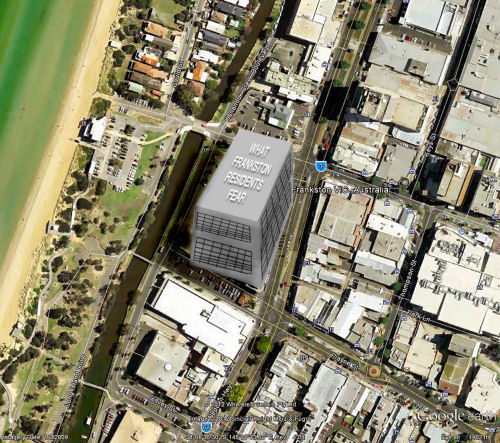
A very dismal record - its time to better defend public space in Frankston. Residents describe an appalling lack of due process, where the planning process is perceived to be without integrity, involving secret deals. State member Geoff Shaw is alleged to have made an election promise to complete the "Peoples' Plaza "on Kananook Creek, but now an 8-10 story office block is going up in its place.
Secret, arrogant, contemptuous treatment of community
State Government /Frankston Council should stop the outrageous abuse of due planning process and the secretive, arrogant and contemptuous treatment of the Frankston community.
The development of the strategic, publicly owned, waterfront site on the Kananook Creek Boulevard has long been seen as holding the key to Frankston’s future. Any development here is of the highest order of public interest; it should engage the widest community and receive the fullest public debate.
On Monday the 10th December Council will approve the design of the South East Water (SEW) high rise Office Block. The building is 8 -9 story high (potentially 10 in the future) and extends for an entire city block from Playne Street to Wells Street.
Charade of public consultation
SEW released the design for public view in the local papers on Tuesday 4th December - effectively giving the community only about three days to comment on the public release of the design. Worse still, from SEW's own communication to its staff, it appears that the Council approval of the design has already been pre-determined-so public release is just a charade- it will have no effective impact at all.
This follows a totally secret deal to sell the strategic site (earmarked as predominantly public space) for a peppercorn price and a further secret deal to circumvent Councils own strict planning laws on building height and mass.
11 Major Issues this development
LIRG has identified at least 11 major issues with the proposal all of which are in the wider public interest and should be fully debated with the community –refer website http://longislandresidents.wordpress.com/
A 3 day viewing process is not designed for open, interactive community debate.
Long Island Residents Group (LIRG) URGENTLY URGES the leaders/concerned residents in the Frankston community to get their Council to:
Defer the decision on approving the SEW high rise office block building design and allow a proper period of public consultation on the proposal.
Rescind the Frankston Planning Scheme waiver to avoid the unwanted consequences of establishing a new precedent on building heights.
State Government /Council bring wide discredit to themselves when they continue to treat the Frankston community in this secretive, arrogant and contemptuous manner.
Council role is umpire, not developer
If Council ignores community concern on the process this Monday night and approves the design it will make the community more determined for reform.
The Councils role must be the trusted umpire, not the gung ho developer- a massive conflict of community interest arises when the planning and developer role are not properly separated.
Furthers concerns are explained at http://www.youtube.com/watch?v=Bea6cROV214
Source: Alert from Long Island Residents' Group (LIRG) - Frankston, Victoria, Australia.
St. Monbiot Island
 The new science of ecology will now describe animals as they really are---moral agents, not biological automatons. And as such, they are to be charged with a moral responsibility to constrain their cravings and live simply so that other animals like them can simply live. Or as they now say on St. Monbiot Island, “Be the reindeer you want the world to be.”
The new science of ecology will now describe animals as they really are---moral agents, not biological automatons. And as such, they are to be charged with a moral responsibility to constrain their cravings and live simply so that other animals like them can simply live. Or as they now say on St. Monbiot Island, “Be the reindeer you want the world to be.”
Island in the Behring Sea Renamed To Reflect New Paradigm

Guilty as charged:
Fat, Greedy and White---guilty ungulate “Rudy” reacts to news that responsibility for the infamous St. Matthew Island Reindeer die-off is now attributed to his appetite, rather than to excessive reindeer numbers. Had he eaten lichen modestly, a scientific report says, other reindeer could have lived and the island’s bio-capacity would not have been exceeded. According to data released by the GHN (Global Hoofprint Network) in San Francisco, if all reindeer consumed as much as Rudy did, four planets would have been needed to supply the species sustainably.
Reuterz News Item:
A 137 square mile island in the Behring Sea made famous by the spectacular increase of an introduced reindeer population of 24 in 194 which became 6,000 in number in just two decades ---only to suddenly collapse in a matter of months by 99% until only 42 were left in 1966---was renamed recently in a ceremony to mark the occasion. http://www.stuartmcmillen.com/comics_en/st-matthew-island
What was once known as “St. Matthew Island”, the remote and desolate island is now to be called “St. Monbiot Island National Park”, in honour of renowned environmentalist writer George Monbiot and his trademark “Monbiot Mantra”--which goes something like this: “Overpopulation has little to do with it--it is our appetite, not our numbers. Especially the gluttony of old middle class white guys looking for a scapegoat to deflect attention from their culpability.”
The decision to rename the island came in the wake of a report commissioned by the Sierra Club—and paid for by billionaire David Gelbaum and several of their big corporate donors like natural gas fracker Cheasepeake Energy---that while greedy reindeer of the Northern Hemisphere make up only 5% of the global ungulate population, they account for fully 25% of the total amount of lichen consumed in a given year. Constant repetition of that statistic is now mandatory for every college student who hopes to graduate with a degree in Environmental Studies, Political Science or Communications. Education ministries across the continent have now determined that rote memorization of clichés like these is more cost-efficient than actually teaching young people four years worth of real science.
In other words, the name change was thought necessary to fit the new paradigm, and signalled a watershed moment in the evolution of environmental thinking. Gone is the hopelessly unfashionable and politically incorrect foundational formula of the environmental movement, which assigned critical importance to the population level of a given species when gauging its ecological impact.
Animals redescribed as moral agents
Henceforth, no researcher or environmental commentator will dare to say that any species will grow its numbers to meet the available food supply (the Hopfenberg Hypothesis). Instead, cultural conditioning ---typically in the form of mass advertising and the promotion of a competitive “keep up with the Joneses” mentality---will be regarded as the key driver of environmental degradation and the demise of all species. The new science of ecology will now describe animals as they really are---moral agents, not biological automatons. And as such, they are to be charged with a moral responsibility to constrain their cravings and live simply so that other animals like them can simply live. Or as they now say on St. Monbiot Island,
“Be the reindeer you want the world to be.”
When asked to comment on the historic name-change and park dedication, Canadian Green Party leader Elizabeth May---an aspiring United Church of Canada Minister---remarked that
“With this announcement, it is to be hoped that the scourge of sociobiology will never again raise its ugly head. Now that it has been laid to rest, biology itself must now finally be exposed for what it is---a fascist concept.”“It is not how many reindeer there are,” she continued, “but how they choose to live. The reindeer on St. Matthew Island could have lived like Ghandi, but instead they chose to live like Gates.”
Ms. May recommended that the environmental movement continue to follow its true mission---the inculcation of guilt for bad behaviour, and the pursuit of “good feelings” among its adherents by making trivial lifestyle changes rather than measuring their success by the achievement of meaningful concrete results.
“Self-righteous self-abnegation and the worship of green pie-in-the-sky technologies is the New Christianity,”
she exclaimed with buoyant pride. Making an obvious pitch to the social media generation, May continued,
“ You can continue to be a dope-smoking, lying adulterer and fornicating flake and be blessed, so long as you go vegan and give up your car.”
Citing the United Church of Canada as her model,
“The Church of Green is inclusive and diverse,”
Ms. May concluded. Moreover, it has been speculated that in keeping pace with evolving standards in the United Church, in the new ‘progressive’ Green Party even unqualified reindeer will not only be welcomed but ordained. (It is not as if the Green Party has set its leadership bar too high, is it?)
The impact of the name-change has already been felt across all North American campuses and Biology Departments, which are now faced with an imminent overhaul. In an arguably futile attempt to save the discipline, Biology Department heads all over North America are now calling their field the “The Sociology of Flora and Fauna” , and in some cases, “The Moral Philosophy of Natural Selection”. Eventually, however, it is expected that biology courses will soon fall under the rubric of “How- Zionism-Caused-the-Sixth Extinction-Event”. Such is the chill that has descended upon academic discourse in the wake of this announcement that when one professor was heard to remark that the fate of St. Matthew’s reindeer might have been related to their unchecked fecundity, his college was quickly censured by the Canadian Association of University Teachers (CAUT) following a complaint from a professor at the Women’s Studies department at Hampshire College. In her words,
“No one should be able to tell female reindeer what to do with their bodies.”
So it is all now official. There is enough lichen in the world to go around, if only it is shared equally and consumed responsibly. Breed on.
Tim Murray
November 22, 2012
Elizabeth May:
Now I don’t claim to be an A student baby or an authentic Green Party Leader either, and I ….
Don't know much about history,
don't know much biology.
Don't know much about a science book,
don't know much about the french I took.But I do know that I love you,
and I know that if you love me, too,
what a wonderful sustainable world this would be.
PS Readers will understand that the quotes cited in the foregoing parody are fictional and made only to highlight the absurdity of predominate green ideology. They are the responsiblity of the author alone. Tim Murray
Deep sea mining off PNG - multiple impacts feared
 Just off the coast of Papua New Guinea there is a huge new 'deep sea mining' venture called Solwara 1 mine. University based environmental scientists in PNG and Australia are worried that the venture is largely experimental and that the entire venture is "out of its depth." They also say that intellectual Property Rights, community and environmental health in the Bismarck Seas and PNG’s Exclusive Economic Zone are inadequately addressed.
Just off the coast of Papua New Guinea there is a huge new 'deep sea mining' venture called Solwara 1 mine. University based environmental scientists in PNG and Australia are worried that the venture is largely experimental and that the entire venture is "out of its depth." They also say that intellectual Property Rights, community and environmental health in the Bismarck Seas and PNG’s Exclusive Economic Zone are inadequately addressed.
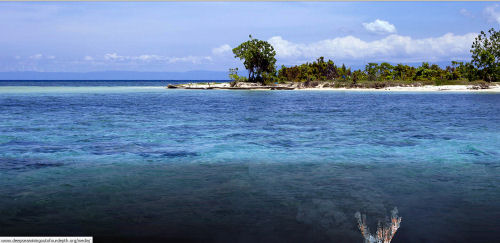
What steps will the PNG Government take now that the PM knows there's an issue?
Today the Deep Sea Mining Campaign will deliver a letter to the Prime Minister of PNG. The letter welcomes Prime Minister Peter O’Neill’s recent statements recognizing the environmental impact of Solwara 1 as a “core issue”.
However, the Campaign is concerned that the PM has not clearly laid out how the PNG National Government will now ensure that environmental impacts are addressed prior to the re-commencement of the Solwara 1 mine.
Professor Chalapan Kaluwin of the Environmental Science & Geography Department at the University of Papua New Guinea states, “The priority issues of intellectual Property Rights, the health of communities and the environment of communities in the Bismarck Seas and PNG’s Exclusive Economic Zone are poorly dealt with. Hence the need for transparency about the decision making process behind the issuing of the 20 year license for Solwara 1 is imperative.”
“DEC made a commitment to inform the public at a forum it was to hold in in Port Moresby last week. But it then cancelled this forum. We now have a window of opportunity to get things right beforeNautilus starts up its operations again. When will our own experts, local communities and our government talk openly and honestly on this matter"
Dr. Helen Rosenbaum, coordinator for the Deep Sea Mining campaign in Australia and author of Out of Our Depth: Mining the Ocean Floor in Papua New Guinea states,
“Solwara 1 is the world’s first deep sea mining experiment. The eyes of the region and the world are watching to see how the PNG Government deals with the flaws in the Nautilus EIS.”“Independent detailed technical analysis has shown there are many errors and omissions and that the EIS fails to provide a basis for the management of environmental risks.”
In its letter to the PM, the campaign maintains that at a minimum the PNG Government and Nautilus must now release:
* the full oceanographic data set for the EIS;
* the 2009 independent review of the oceanographic aspects of the EIS conducted for DEC by Cardno Lawson Treloar Pty Ltd;
* any other independent reviews of the EIS commissioned by DEC;
* the conditions of the Solwara 1 permits issued to Nautilus by DEC;
* the draft environmental management plan for Solwara 1; and
* studies that show what metals will be released, the extent to which they will find their way into the food chain, and how contaminated the seafood eaten by local communities will be.
Wences Magun, National Coordinator for the Madang based Mas Kagin Tapani said, “Local communities have NOT sanctioned the Solwara 1 project. No one knows what the impacts of this form of mining will be. Communities want to know what concrete steps the Prime Minister will now take to ensure we are not being used us as guinea pigs in a sea bed mining experiment.”
The letter to Prime Minister O'Neill can be read here:
http://www.deepseaminingoutofourdepth.org/letter-to-png-pm/
For more information:
Professor Chalapan Kaluwin (Papua New Guinea), [email protected] + 675 7122 5454 ?
Wences Magun (Papua New Guinea), [email protected] +675 7195 9665,
Dr. Helen Rosenbaum (Australia), [email protected] +61 413 201 793
International concern at imminent changes to Australia's National Environment law (EPBC Act)
 David Attenborough and other renowned conservation figures have urged PM Gillard to retain National Environment Powers. At the moment changes devolving major decision making to our growth-mad developer states are imminent. The writers of a letter to the Primeminister say that their concern arises particularly due to Australia being "one of a very few biologically mega-diverse developed countries on the face of this Earth. The array of natural ecosystems and their component species is simply breathtaking, making Australia one of the most important and exciting places in the world for the long-term conservation of biological diversity." See also this article which contains links to petitions etc.
David Attenborough and other renowned conservation figures have urged PM Gillard to retain National Environment Powers. At the moment changes devolving major decision making to our growth-mad developer states are imminent. The writers of a letter to the Primeminister say that their concern arises particularly due to Australia being "one of a very few biologically mega-diverse developed countries on the face of this Earth. The array of natural ecosystems and their component species is simply breathtaking, making Australia one of the most important and exciting places in the world for the long-term conservation of biological diversity." See also this article which contains links to petitions etc.
Sir David Attenborough urges Prime Minister not to abandon National Environment Powers
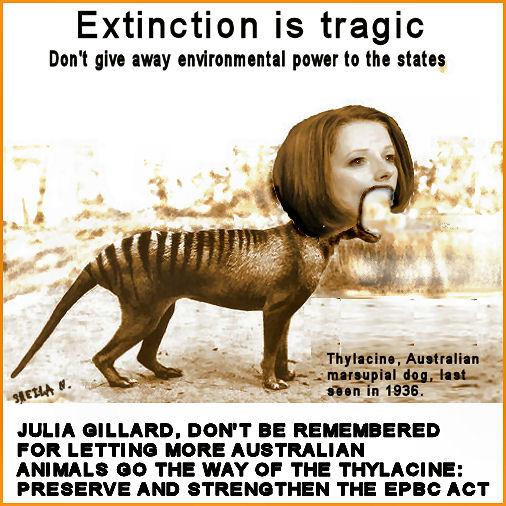
Today, 23 November, 2012, 33 United Nations Environment Program Global 500 Laureates (elected to the UNEP Global 500 Roll of Honour in recognition of outstanding practical achievement in the protection of the environment) delivered Prime Minister Gillard a letter urging her not to abandon national environmental protection and devolve powers to state and territory Governments.
Among the signatories are Sir David Attenborough and five of the world’s most influential conservation biologists: Drs Paul and Anne Ehrlich from Stanford University, Dr Peter Raven, President Emeritus of the Missouri Botanical Gardens, Professor Tom Lovejoy from George Mason University in Washington DC, and Professor Norman Myers from Green College, Oxford University. These are the men and women - the pioneer whistle blowers, who told of the massive loss of species and habitats facing the planet, and of the threat of climate change - going back nearly 40 years.
Also signing on is Veit Koester, who successfully and brilliantly chaired the global negotiations for the Convention on Biological Diversity, the treaty that provided the “head of power” for the Commonwealth’s powerful Environmental Protection and Biodiversity Conservation Act, 1999 (EPBC Act). Joining the 33 signatories is prominent Australian Dr Don McMichael CBE, who chaired the inaugural Federal Biological Diversity Advisory Committee, which prepared the very first draft “National Biological Diversity Conservation Strategy” for Australia.
In their letter the Global 500 Laureates state: “We have been concerned to hear however that there are proposals in train to weaken the EPBC Act and to allow the states and territories to approve developments affecting Matters of National Environment Significance without any Commonwealth oversight. We believe this would be a retrograde step in relation to the development of environmental law in Australia, with significant and negative implications for the conservation of biological diversity and achieving ecologically sustainable development”.
The letter, organised by Humane Society International (HSI) Director and Global 500 Laureate, Verna Simpson, has been presented to the Prime Minister just weeks before the Council of Australian Governments (COAG) meets in early December, to discuss the ongoing administrative process for handing over Commonwealth environmental powers, which has a March 2013 deadline. The Government appears not to be listening to Australia’s professional environmental community, but this letter clearly indicates the global concern for the potential deterioration of effective national environmental regulation in Australia.
The Global 500 Laureates concluded: “The individual and organisational UNEP Global 500 Laureates below would like to offer our support for a continuation of your Government’s efforts to develop best possible policies and practices for the conservation of biological diversity through the maintenance of the current powers contained within the EPBC Act, and to avoid, at all costs, the devolution of such powers”.
You can read the full letter here: Letter entitled, "Strong national environmental protection laws".
See also this article which contains links to petitions etc.
Source
This article was based on a press release from the Humane Society International (HSI).
HSI concentrates on the preservation of endangered animals and ecosystems and works to ensure quality of life for all animals, both domestic and wild. HSI is the largest animal protection not-for-profit organisation in the world, with over 10 million supporters globally and has been established in Australia since 1994.
Kelvin Thomson MP: Dear PM, please don't wind back critical environmental protection laws
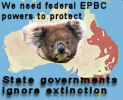 Kelvin Thomson, MP for Wills, has written to Prime Minister Gillard, asking her to consider and respond to the concerns of constituents about planned changes to the federal environment act. Have any other ministers done this? We would like to hear from them if so. See also this article which contains links to petitions etc.
Kelvin Thomson, MP for Wills, has written to Prime Minister Gillard, asking her to consider and respond to the concerns of constituents about planned changes to the federal environment act. Have any other ministers done this? We would like to hear from them if so. See also this article which contains links to petitions etc.
Federal Caucus working on an Independent Office of Animal Welfare model
 Federal Caucus has carried a motion to have the Caucus Live Animal Export Working Group develop a model for an Office of Animal Welfare. We know of two MPs who actively support this motion and would like to hear from any others. Kelvin Thomson and Melissa Parke, respectively MPs for Wills in Victoria and Fremantle in West Australia support this approach.
Federal Caucus has carried a motion to have the Caucus Live Animal Export Working Group develop a model for an Office of Animal Welfare. We know of two MPs who actively support this motion and would like to hear from any others. Kelvin Thomson and Melissa Parke, respectively MPs for Wills in Victoria and Fremantle in West Australia support this approach.

Tuesday, 27 November 2012
Independent Office of Animal Welfare
Kelvin Thomson (Member for Wills) and Melissa Parke (Member for Fremantle) have welcomed the carriage by Caucus of a Motion to have the Caucus Live Animal Export Working Group develop a model for an Office of Animal Welfare.
The proposal will consider the location of the office within government, and the legal status of the office. The preferred model will be presented to Caucus by the end of February 2013.
“We are pleased that the Parliamentary Labor Party has responded to the recent revelations about the disgraceful treatment of Australian sheep exported to Bahrain and Pakistan. We hope that the Live Animal Export Working Party will come up with
a model which helps secure decent and humane animal welfare outcomes. We believe this is what Australians want.”
Source: Press Release from Kelvin Thomson's office.
Labor handing environmental law back to growth mad developer States
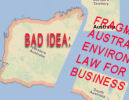 This Friday, 7 December, the Federal Government plans to give away environmental assessment authority to the states. Candobetter readers should take any opportunity they can to avoid this devolution of our already semi-toothless legislation. Here is an opportunity to add your signature to a petition. There is also a Get-up campaign. Readers are invited to let us know of any other actions they are taking.Links to petitions etc inside.
This Friday, 7 December, the Federal Government plans to give away environmental assessment authority to the states. Candobetter readers should take any opportunity they can to avoid this devolution of our already semi-toothless legislation. Here is an opportunity to add your signature to a petition. There is also a Get-up campaign. Readers are invited to let us know of any other actions they are taking.Links to petitions etc inside.

What is the EPBC Act and why is it such a big deal?
Virtually the only functioning piece of environmental legislation in Australia is the Environment Protection and Biodiversity Conservation Act (1999), or the EPBC Act. It is the only law that individual citizens can bring a complaint under. The state environmental laws require you to find an officer in a government department or some other rare organisation with 'standing' who will bring a complaint for you. If you have tried to do this you will realise how this is almost impossible. Wildlife organisations and carers see grotesque crimes daily and cannot interest state bodies.
Under the federal EPBC legislation, the Federal Environment Minister, Tony Burke, has responsibility for assessing and approving (or rejecting) major development that will impact our nationally important places and wildlife, such as our World Heritage areas, threatened species and nuclear actions like uranium mines or nuclear waste dumps.
Apparently, due to industry lobbying (notably from the Business Council of Australia) and without consulting the Australian public, the government is gutting these laws and handing over most, if not all, of these federal responsibilities over to the States.
This means that Premiers like Campbell Newman, Collin Barnet, Ted Bailieu, Barry O'Farrell, etc., will be left solely in charge of protecting our Environment and World Heritage areas like the Great Barrier Reef. Since power over land and water resides in the states and they make much of their money out of buying, selling and regulating these for profit, they have a vested interest in developing land. The states are notorious for ignoring environmental law in favour of big money and development.
December 7, 2012 is D-Day for Environment
On December 7th, the Prime Minister and Tony Burke intend to hand over their environment responsibilities to the states through the Council of Australian Governments (COAG). Recent hard-won environmental protection in Australia has only been possible when the Federal Government stepped in to overrule bad state government decisions. See, most recently, Tony Burke shows courage in giving NSW and QLD koalas threatened status As the Australian Greens note, "If the States were in charge of the environment, they would have damned the Franklin River, put oil rigs in the Great Barrier Reef and let Traveston Dam go ahead."
Make no mistake; fracking, massive open-cut coal mining, huge housing developments, desecration of the Kimberlies, cattle on the highlands, fragmenting, farming and selling off of national and regional parks - will all be on state agendas.
Environment groups and scientific bodies like the Wentworth Group all agree – this change, being rushed through by COAG at the behest of big business - is the worst thing to happen for environmental protection in Australia for thirty years.
Petition to sign
The Australian Greens have put out a petition to sign http://greensmps.org.au/content/petition/minister-burke-dont-hand-your-powers-states and share with your networks.
Get-up Campaign
http://www.getup.org.au/keep-federal-govt-enviro-powers Also asking for donations at Get-up and for a lot of information about you.
Disclaimer from Editor at Candobetter.net: Note, the petition is from the Australian Greens, some of whom have shamefully ignored population pressure from high immigration and have caused debate to focus on asylum seekers. They are now - oh so belatedly - calling on people to use them to support environmental laws. Despite these failings, the Australian public need to use this opportunity to try and defend their environmental legislation (which still needs to be much much stronger) as well as to use any other opportunities that may arise. So please consider signing. And similar for Get-up, which also ignores population and insists on getting a lot of information out of you which is no doubt useful to on-sell.
Source: Press release from the Australian Greens and the Humane Society International, and independent research. Contact was also attempted with the federal office of Environment Minister Tony Burke by phone and by email, but no-one was available to comment on the day that this article was written. If we receive a response to our email we will take it into consideration.
Green Wedges Rally: Melbourne Groups call for curb to immigration and expansion
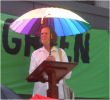 Not so livable Victoria - Melbourne rally calls on government to curb immigration and stop advertising for new settlers overseas for Victoria in view of environmental and amenity impacts of huge population
Not so livable Victoria - Melbourne rally calls on government to curb immigration and stop advertising for new settlers overseas for Victoria in view of environmental and amenity impacts of huge population
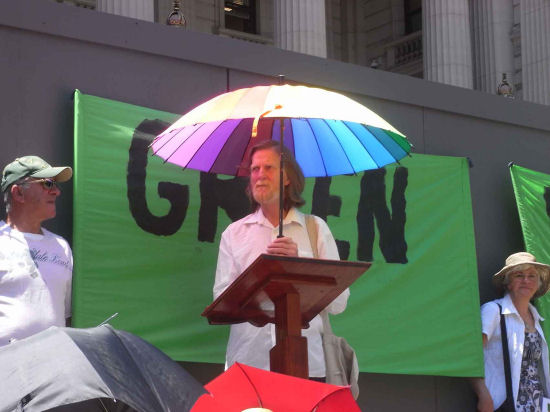
Despite record high temperatures - on 29 November, the hottest day on record for that month - about 80 concerned leaders of activist groups in Victoria attended the "Stop the Planning Disaster Rally" organised by Rosemary West of Green Wedges Coalition Victoria. Supporters gathered on the steps of Parliament on Thursday 29 November. Many representatives of peak group members of Protectors of Public Land Victoria were present.
Resolutions Moved
Resolutions Moved at Rally “STOP The Planning Disaster” 29 November 2012 on the Steps of Parliament
This rally calls on the State Government:
1 To abandon proposed changes to the commercial, green wedge and rural zones.
2 To revise new residential zones by:
i. Excluding retail, office and other inappropriate commercial uses;
ii. Excluding multi-unit development from the neighbourhood residential zone;
iii. Including mandatory height controls and density controls on all multi unit development in conjunction with local councils and residents; and
iv. Strengthening heritage protection through rewriting the heritage legislation.
3 To retain the democratic right of residents to object to and appeal planning/development proposals.
4 To abandon the East West Link tollway and implement the Rowville, South Morang, Doncaster and Tullamarine rail projects.
5 To lobby the Federal Government to curb immigration and stop advertising for new settlers overseas for Victoria in view of the environmental and amenity impacts of the huge population boom and of State Government failure to provide for infrastructure.
6 To refer legitimate planning zones review to the proper forum - the Parliamentary Standing Committee on the Environment and Planning – and to allow a new six-month public consultation period.
Moved Rosemary West, Green Wedges Coalition Inc.
Seconded Julianne Bell, Protectors of Public Lands Victoria Inc.
Some groups came from as far away as the Mornington Peninsula. Celebrity Rod Quantock performed the role of MC of the rally (see attached photo taken by Jill Quirk President Sustainable Population Australian Inc. of Rod against the Green Wedges banner.) Among the speakers were Professor Michael Buxton of RMIT; Colleen Hartland Member of the Legislative Council for the Western Metropolitan Region; and Brian Tee Shadow Minister for Planning and Sustainable Growth, Member of the Legislative Council for the Eastern Metropolitan Region. People also stayed to speak in the "Open Mike" segment at the end of the rally, despite the searing temperatures.
December 4: PortSea Beach BlueWedges urge PoMC to put money where mouth is
 Join us at Portsea Pier at 12 Noon Tuesday 4th December. We’ll have a bucket of money that we’ll hand back to the PoMC when Portsea beach comes back.
Join us at Portsea Pier at 12 Noon Tuesday 4th December. We’ll have a bucket of money that we’ll hand back to the PoMC when Portsea beach comes back.
Please come back Portsea Beach!
PoMC can have its $100 million bond back when we get our beach back!
Join us at Portsea Pier 12 NOON TUESDAY 4TH DECEMBER 2012
The Port of Melbourne Corporation is due to get its $100 million Channel Deepening Environmental bond back very soon, because all the science the Port Corporation has produced says everything is fine and there are no lasting impacts from the biggest dredging project ever undertaken in the Bay.
PoMC says problems at Portsea beach are cyclical and weather related, and that beaches come ago.
Sure – we agree that beaches come and go.
But Portsea Beach disappeared swiftly in 2009 and it hasn’t come back.
Now ocean swell regularly pounds the shore. All the shady trees and golden sands have gone - replaced with rocks and a massive sandbag wall. The once picturesque and safe family beach is just a memory.
All since deepening The Entrance and despite $millions of taxpayers dollars in “protective” works.
All the swells at Portsea 2012
So….……. If PoMC is so sure Portsea Beach will come back, how about the environmental bond stays in State coffers until the beach comes back.
That’s fair isn’t it?
When Portsea beach comes back PoMC can have its bond back.
Win Win!
In the meantime, the $100 million can be earning interest for us taxpayers to offset what’s been spent trying in vain to save the beach.
Join us at Portsea Pier at 12 Noon Tuesday 4th December. We’ll have a bucket of money that we’ll hand back to the PoMC when Portsea beach comes back.
Swiss Eco Group Forces Immigration Vote

 A left-wing environmentalist group opposed to all forms of racism and xenophobia has been able to get a national immigration referendum on the ballot in Switzerland.
A left-wing environmentalist group opposed to all forms of racism and xenophobia has been able to get a national immigration referendum on the ballot in Switzerland.
Philippe Roch (R) from the Ecopop group.
The Environment and Population Association, or Ecopop group, successfully argued that overpopulation from massive immigration is putting undue pressure on Switzerland’s finite natural resources.
“The pressure on land, nature and the countryside is considerable, and quality of life is continuously deteriorating due to a lack of living space,” Ecopop member Philippe Roch told the BBC.
Roch is also a former director of Switzerland’s Federal Environment Office.
The group wants annual population growth through immigration capped at 0.2% and a tenth of foreign aid to be used for birth control measures abroad.
Ecopop members gathering signatures
Direct democratic action a right in Switzerland with referenda
More than 120,700 certified signatures, far above the minimum 100,000, were gathered to get the referendum on the ballot on November 2. Although no date for the vote has been set yet, should the initiative clear other administrative and legal hurdles, it will likely take place in 2015. ( For more on how Swiss direct democracy works and why this system would be desirable in Australia, see
"You can help bring Direct Democracy to Australia.")
Population numbers in Switzerland
Switzerland’s population has risen by some 15-percent since 1990. It currently has a population of eight million, with a quarter of them being foreigners.
“Switzerland currently has one of the densest populations on the planet, with 480 inhabitants per square kilometre in ‘Mittelland’,” or central Switzerland, Ecopop leader Andreas Thommen told AFP, insisting “this development is not at all sustainable in the long-term.”
The Swiss government re-imposed immigration limits on the so-called “A8? EU nations – Czech Republic, Estonia, Hungary, Latvia, Lithuania, Poland, Slovakia, and Slovenia - last April. After the 2,000-a-year cap expired in 2011, numbers from those countries exploded to 6,000. Many from the relatively-poor countries are attracted to Switzerland due to its low unemployment rate, which is currently 2.9-percent.
Ecopop logo 
Switzerland’s population has is 3.0-percent more now than it was in November 2011, due completely to immigration.
The right-wing Swiss People’s Party has also been able to get an immigration referendum on the ballot.
Ecopop was founded in 1971, with a mission of protecting Founded in 1971, Ecopop says its mission is to protect the environment by restricting immigration and slowing down population growth.
Fire taxes and people taxes - population growth sure costs us!
 Fire taxes and people taxes - Are we seeing the genesis of what could well be the next tax imposition for the people of Victoria to pay for the population growth that the state forces on us?
Fire taxes and people taxes - Are we seeing the genesis of what could well be the next tax imposition for the people of Victoria to pay for the population growth that the state forces on us?
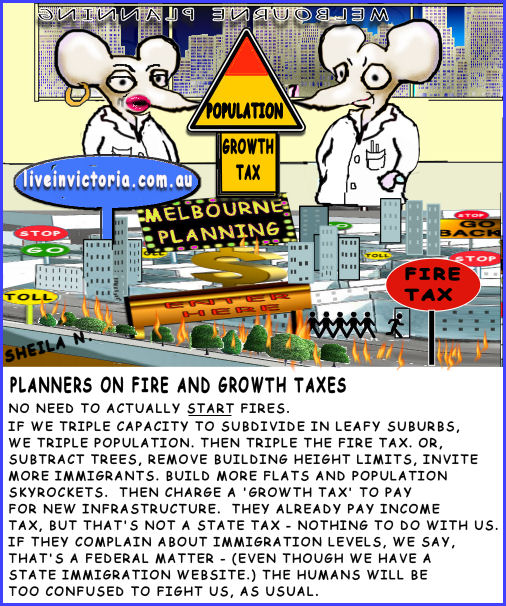
It’s been clear for many years that population growth is costing us all big time in Australia and that’s just the money side of it. I’ll set aside the impact of population growth on the environment, the welfare of other animals, our amenity and livability for another discussion.
About 10 years ago, it dawned on the people I know that population growth was not just something that happened on the outer fringes of the capital cities where we never go but that it was pushing its way into the established suburbs. At first, relatively unnoticed but as the rate and volume increased, we all watched in dismay as neigbouring suburban gardens disappeared, houses were demolished for larger, bulkier edifices and our familiar mix of built and un-built environment was transformed into something that would be unrecognizable to anyone who had been absent for a decade. The word “infrastructure” then insidiously crept into our media lexicon ad nauseum. Services such as sewerage and roads and provision of power that we took for granted as being provided by various arms of government suddenly seemed to be in a crisis of ageing and inadequacy. We all knew that there was a cost to this, ultimately payable by tax payers, but most people I spoke to saw this as being long into the future to the point they did not need to worry about it.
Dr Jane O’Sullivan http://www.onlineopinion.com.au/view.asp?article=10137 in March 2010, highlighted and quantified the inevitability of this burden with a reasonable assumption that the average lifespan of infrastructure would be conservatively 50 years so that on an annual basis this would amount to no more than 2%. If population growth is 2%, as it had been around the time she wrote the article, then the infrastructure capacity must be doubled! This is the position our growth obsessed governments are putting Australian citizens in.
The last growth figures (to March 2012 on the ABS website show a national growth rate of 1.5%) but this is still very high for a developed country. Victoria had the largest numerical increase in population in that year of any state- 82,500
So, the next blow to Victorians is that a planning academic called Roz Hansen has suggested to the state government that they impose a levy based on the value of people’s properties (and therefore adding to house price inflation) to pay for the additional infrastructure necessitated by population growth. This might be OK for someone like Roz Hansen, who we might reasonably assume has a hansome salary as planning adviser to the Baillieu government, but for people on retirement incomes living in ordinary suburbs, it could well mean not being able to afford to stay in their homes!
The Premier is in the clear so far, having said “no” to this idea. It is now on the agenda, however!
The Municipal Association of Victoria does not want the collection of such a tax to be imposed on councils and points out that people do not have unlimited resources. Victorians will also be paying a fire levy from July 2013 and the government proposes doubling the population of bushfire prone townships such as Warrandyte and urban suburbs by allowing 2 houses per residential lot.
Any tax based on the price of a property can become unaffordable to the resident as population growth drives up the price of housing without creating any more real wealth. Although the Georgists http://en.wikipedia.org/wiki/Georgism advocate a tax to property owners based on land value, in a “Geoist” world there is no income tax on wages. Hansen’s suggestion is Geoism without the benefits, although I doubt that this would be a conscious all encompassing tax philosophy on her part. She would still expect us to pay income tax with land-tax a new and additional impost.
What is frightening is that the population growth that drives such draconian potential policies is inflicted upon Victorians against their will, but our political system seems to provide us with no means to stop what over 70% of Victorians manifestly do not want. If a related new tax or charge is imposed, we also have almost no chance of stopping it, since such things tend these days to be decided in parliament, between elections and never to be submitted as items on political platforms at election time. And who can keep up with the sophistry? Isn't there more to life?
Planning for overpopulation - do we really need it?
 Is the Department of Planning in the Victorian State government vital to our lives or is it just part of endless population growth ? The Planning Department operates with a seemingly remarkable ignorance of the realities of resource (especially oil) depletion, some apprehension of climate change, scant reference to the environment, and no mention of creatures other than humans. Something funny's going on.
Is the Department of Planning in the Victorian State government vital to our lives or is it just part of endless population growth ? The Planning Department operates with a seemingly remarkable ignorance of the realities of resource (especially oil) depletion, some apprehension of climate change, scant reference to the environment, and no mention of creatures other than humans. Something funny's going on.
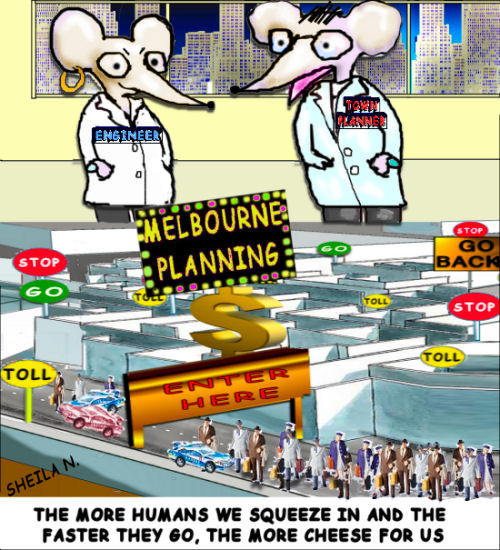
Self-perpetuating planning
A friend and I recently were discussing disconsolately the current Victorian State Minister for Planning’s zone reforms and the department’s Metro Planning document "Melbourne, Let’s talk about the future." The purpose of both seem to be to facilitate more development, to make life easier for developers and to remove obstacles. I maintained that the more development that is allowed, the more disruptive the activities will be and the less certainty residents of Melbourne will have of the continuing amenity of their surroundings. Au contraire, they will live with the certainty that their amenity will decline.
My friend tends not to be rebellious but, like a lot of people, can see that there are powers behind the scenes at work in our lives. She came out very firmly saying, “Well you’ve got to have planning, other wise you will end up with a hotch-potch of development." The more adamant she was about this, the more I wondered if what she said was indeed true.
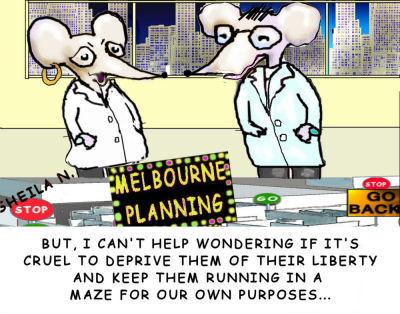
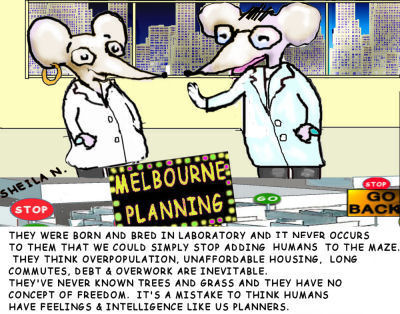
Planning in its current form seems to be all about accommodating population growth. It is about more and more human activities, buildings, roads, bridges houses. But does planning need to be exclusively about more of us and more of what we do, continually modifying our natural environment and pushing out other species?
Planning without growth
What would our Department of Planning do if growth was slow or non existent? Would the planning Department be able to justify its existence? What sort of changes would then need to be planned for? There could be changes in the age structure of the population which might require different services. But are these the domain of the planning department? Couldn’t the Department of Human Services take care of this? Then there are changes to the types of energy sources that must be provided. Energy is privatized in Victoria but the Department of Primary industry now has the role of overseeing energy distribution and invests in new technologies (according to its website).
Because of past and present population growth, Victoria and all of Australia is way behind with infrastructure provision, so the Planning Department could put their minds to this and, for the first time in our lives, we might be adequately provided for in this respect. Or could an ‘Infrastructure department” take care of that? With a stable or near stable population, houses would still need to be built for a time as there are not enough roofs to cover the heads of the current population. Could the Planning department focus on that? Or would housing be best in the hands of the Department of Human Services? It is after all a basic human need. It would not make a terribly impressive glossy coloured document, but the homeless would be impressed.
Self-important planners
With rapid population growth as we have suffered for the last decade, which of the State government ministers gets the most press attention? I think it is the Planning Minster. This attention is not a compliment to him nor to his predecessor though. They both hit the news because development decisions are controversial and permanent in nature with a few winners and many more losers.
With a stable or very slowly growing population, planning would no longer be “famous” as it is now in Victoria. Would it even be necessary as a separate entity?
Those in power need to look to the future because they make decisions that endure long term. The Planning department seems to respond to the greed and desires of the growth lobby by facilitating growth. With superficial buzzwords and motherhood statements in the document “Melbourne, let’s talk about the future,” the Planning department foreshadows a real shock for residents of regional towns such as Geelong and Ballarat. With the mantra, “Planning for regional city growth is vital,” the Department glibly writes off our future hope of livability by embracing growth like an adored relative and with a seemingly remarkable ignorance of the realities of resource (especially oil) depletion, some apprehension of climate change, scant reference to the environment, and no mention of creatures other than humans.
Sheila Newman has just published new theory in a new book, Demography, Territory & Law: The Rules of Animal and Human Populations (see link). Forensic biologist, Hans Brunner writes of it: "This book takes us to a completely new paradigm in multiple species population science. It shows how little we understand, and how much we need to know, of the sexual reactions when closed colonies with an orderly reproduction system are destroyed, be it people or animals." Two chapters are on multi-species demography, the rest apply the theory to non-industrial societies and the author comes up with a completely new test for the collapse model of Easter Island, which will stun those who thought they knew all about it.
“You’ve got to have Planning” (with a capital P)?
Let’s try life without it.
No politicians with ideas, please!
 Kevin Rudd and Malcolm Turnbull like many other politicians seem to think of themselves as ideas men. Do we really need politicians with 'ideas' or are they a liability?
Kevin Rudd and Malcolm Turnbull like many other politicians seem to think of themselves as ideas men. Do we really need politicians with 'ideas' or are they a liability?

On Monday night’s Q and A on ABC1 TV, guests Kevin Rudd and Malcolm Turnbull, from the comfort of their respective non party leadership positions (and in Kevin Rudd’s case basking in the imagined glory of the way he would now be leading the country had it not been for the 2010 leadership coup) quipped and bantered between themselves throughout the show.
Especially not big population ideas
Their harmonious good humour finally evoked the question from an audience member as to whether they had considered jointly forming a new political party, to which they both agreed that they had not. Kevin Rudd even surpassed himself in wit saying that they would not be able to agree on the leadership (of such a party)! During the program I heard one of them say that he had “a few good ideas” as did the other (giving the other due credit ) In other words they are a pair of mutually self proclaimed “ideas people”. I hate to think what those ideas are and am 100% certain that they would involve a huge population for Australia. Both men are on record as advocating this.
I suppose whichever of Tweedle Dum and Tweedle Dee said that they of had "ideas” thought that the idea of their ideas would be enticing to the audience.
But do we really need politicians to have ideas?
It always seems to be the materialization of someone’s big idea that clashes with the needs and wants of others and with nature. Politicians should be in the business of appreciating what we have and trying to withstand assaults on it rather than contributing their own ideas to its transformation along with the myriad developer and big business ideas that we are assailed with.
Megalomaniac dreaming
Two megalomaniacs dreaming up an Australia which is nothing like the Australia we live in is not what Australia needs. The best tools for a politician are a set of guiding principles and a philosophy.
Politicians with ideas just make more work for the rest of us. We have to correct them, modify them, try to premept them and pay for their projects whether we like them or not. We have to interrupt our own lives to try to avert the disasters their ideas can become.
Overactive children
It is a bit like cleaning up after a very imaginative and active child has been in the house all morning playing in the kitchen cupboards. The unfortunate difference with politicians who have ideas and want to make their mark is that the results are more costly. We have far more difficulty controlling them and we can’t lock them in their rooms when they make a mess.
Ideas are great for those in creative fields. If an artist has an idea and chooses to put it on paper or canvas, that’s fine whether I like the idea or not. Unless I am forced to hang the picture in my house it doesn’t affect me. A friend’s ideas expressed in very bad poetry are OK unless he asks to read them aloud to me. It’s when you get into the materialization of large scale ideas such as buildings, roads, bridges and other engineering works as well as large populations that the sensitivities of the rest of us collide with the ideas person.
I’ve convinced myself. We do not need politicians with ideas. We actually need them not to have ideas, and for them to take expert independent advice for their decisions. Apart from this I would appreciate it if they could keep things running smoothly in the background so that I can get on with my life.
Melbourne Future Planning - PPLVic submission
 The consideration of the Planning Zones Review should have been referred to the Parliamentary Committee for Environment and Planning which has considerable resources to put the 2,000 submissions on the Parliamentary website and then record on Hansard the hearings of some of the submitters before the Parliamentary Committee.
The consideration of the Planning Zones Review should have been referred to the Parliamentary Committee for Environment and Planning which has considerable resources to put the 2,000 submissions on the Parliamentary website and then record on Hansard the hearings of some of the submitters before the Parliamentary Committee.

Submission to Department of Planning and Community Services (DPCS) on Victoria’s New Planning Zones
Introduction: I am writing on behalf of Protectors of Public Lands Victoria Inc., a coalition of 80 community, environmental and heritage groups dedicated to protecting and maintaining sites of environmental and heritage significance.
Here is a statement made by Professor Michael Buxton of RMIT covering the significance and the impact on Melbourne of the new zone proposals. He gave permission for me to quote him. I am then making a suggestion as to the need for a Parliamentary Inquiry by the Standing Committee on the Environment and Planning in order for there to be proper consultation with the public.
Significance of Review of Planning Zones: The Victorian government’s proposed new planning zones are the most radical review of planning schemes in the history of Victorian planning. They will lead to fundamental changes in the way Melbourne operates, change the fabric of the city and its hinterland, and remove an extensive range of existing citizen rights. Every citizen will be affected.
The new zone proposals will
• Replace the three existing residential zones with three new residential zones
• Replace the Business 1, 2 and 5 zones with a new Commercial 1 zone, and the Business 3 and 4 zones with a new Commercial 2 zone
• Extensively alter the Green Wedge zone, rural Conservation zone, Green Wedge A zone, Farming zone, Rural Activity zone and Rural Living zone
• Change the existing Mixed Use zone, Township zone and Low Density Residential zone
• Change the existing Industrial 1, 2 and 3 zones.
The government recently released the report of the Advisory Committee into the Victorian planning system and its response to this report. Neither this report nor the government response advocated the changes to zones now proposed. No other justification or strategic context has been provided for the radical changes to the statutory planning system. Clearly, the government worked extensively on its changes to zones in a secret parallel process while the public was diverted to a public process which proposed only moderate change.
Impact of New Planning Zones: The major impacts will be the introduction of extensive commercial uses into residential areas, the destruction of Melbourne’s traditional strip retail centres, the dispersal of commercial activities to car based areas resulting in serious metropolitan wide traffic congestion, the de-facto removal of the urban growth boundary and the extension of a large number of urban related uses into green wedges. Resident rights of notification and objection will be seriously curtailed with many new uses allowed in these new zones without the need for permits.
In particular, the zones will:
• merge residential and commercial uses across urban zones, with an extension of commercial uses into residential areas and little difference between commercial and some industrial zones
• increase the price of commercial and rural land through the encouraging of land speculation
• lead to the growth of large numbers of out-of-centre car based commercial/retail developments including accommodation which will end the current functions of many strip retail centres and lead to substantial car use and increase road congestion across Melbourne
• increase the height of commercial/retail and mixed use developments.
The new zones constitute a largely deregulated land use planning system drawing from the reports and lobbying of market oriented bodies and development groups and growth focused government agencies. These zones, in effect, constitute unfair competition by attempting to allow a wide range of uses in many locations. Existing strip retail centres, for example, will have to compete against new retail development built on much cheaper land far from public transport; land traditionally used for agriculture and rural pursuits will become locations for urban related commercial development and accommodation facilities in unfair competition against higher priced urban land. The principle of unregulated markets also takes no account of their public economic, social and environmental impacts, for example, the impacts on congestion of dispersed commercial development and the associated costs in delays and road construction and maintenance.

The application of the zones and the use of schedules will be subject to ministerial approval. Councils may not be allowed to select zones they regard as appropriate to land in their municipalities.
The use of overlays and structure plans may not significantly reduce the impact of the zones. For example, the Heritage Overlay is increasingly ineffective in preventing development even under current zones, and the effects of structure plans depend on the content and the nature of their incorporation into planning schemes.
Melbourne will not be the same city if these new zones are approved even in a modified form.
Failure of the State Government to Consult Victorians Properly on New Planning Zones:
Here is my comment. This complex set of proposals concerning the new planning zones was sprung upon the public which was given only a month to comment. As commented above it appeared that the public was seriously misled as …“Clearly, the government worked extensively on its changes to zones in a secret parallel process while the public was diverted to a public process which proposed only moderate change.” A number of Councils held planning forums at which planning officers attempted to enlighten the public re detail of the changes. The public encountered difficulties when attempting to make submissions by the deadline last Friday when the DPCS computer crashed. The Planning Minister then gave the public an extension for a week. Our submissions will be referred to a small committee hand picked by the Minister. Members of the Committee cannot be said to be independent.
It is extraordinary that the Planning Minister did not refer the review which is of such great significance to the Parliamentary Standing Committee on the Environment and Planning. This has not had an inquiry for the past month or so. Public submissions (to this Standing Committee) are put on the Parliamentary website and presentations to the Committee recorded in Hansard. As far as I am aware most members of the public regard this process as open and transparent where people are given a “fair go”. Even if members of Parliament are split on Party lines they can write a group dissenting report. Protectors of Public Lands Victoria Inc recommends that a proper Parliamentary Inquiry be held into the new planning zones.
Julianne Bell
Secretary Protectors of Public Lands Victoria Inc.
PO Box 197
Parkville 3052
Melbourne Future Planning shades of Judge Dredd dystopia
 Community groups are making submissions on the Reformed Zones in Victoria. The government's zoning aims to increase commercial areas into residential areas in a serial manner and to intensify activity in the green wedges. The Department of Planning and Community Development has appointed a Ministerial Advisory Committee 'to review all submissions and provide advice back to the government', but the Chairman of the Committee is Geoff Underwood, who is prominent in the affairs of the Australian Population Institute (APop), which is officiated by professional developers and has the primary aim of promoting a huge population for Australia. What chances do robust submissions have with APop defining the parameters of planning in Victoria? See Planning Backlash submission inside.
Community groups are making submissions on the Reformed Zones in Victoria. The government's zoning aims to increase commercial areas into residential areas in a serial manner and to intensify activity in the green wedges. The Department of Planning and Community Development has appointed a Ministerial Advisory Committee 'to review all submissions and provide advice back to the government', but the Chairman of the Committee is Geoff Underwood, who is prominent in the affairs of the Australian Population Institute (APop), which is officiated by professional developers and has the primary aim of promoting a huge population for Australia. What chances do robust submissions have with APop defining the parameters of planning in Victoria? See Planning Backlash submission inside.

The zones in question have as their stated objectives 'to better manage growth' and to 'simplify requirements' and to 'allow a broader range of activities to be considered' and 'to ensure that they still reflect the aspirations of all Victorians'.
Despite the latter objective, the zoning, if it remains as it is, will increase the intrusion of commercial areas into residential areas in a serial manner and intensify activity in the green wedges. The government has appointed the Ministerial Advisory Committee to consider all submissions, but the Chairman of the Committee has been prominent in the affairs of the Australian Population Institute from its beginning. APop is officiated by professional developers and has the aim of promoting a huge population for Australia. Along with billionaire, Richard Pratt and Steve Vizard, it played a major role in ex-Premier Steve Bracks's 2002 Melbourne Population Summit which began the current campaign to institute population growth as a norm for Australians and used sophisticated propaganda techniques to do this. See /node/594#comment-981and http://candobetter.net/node/149
The members of the committee are:
Geoff Underwood, Secretary to the Victorian Branch of APop http://www.apop.com.au/who.html
Chris Canavan, QC, represented Hotel Windsor Holdings in their bid to get an extension in time for redevelopment, which had been denied them by this [Baillieu] government.
Joanna Stanley, Communications Consultant with the particular specialty of "Advocacy and influence through media and stakeholder relations," but who is better known as the media spokesperson at Brunswick Residents Unite.
Liz Johnstone, Planner, Planning Institute of Australia and Manager, Planning Policy & Projects, Municipal Association of Victoria (MAV).
Planning Backlash's submission
Below is Planning Backlash's submission to the 'Reformed zones for Victoria' Ministerial Advisory Committee. It begins by thanking the Minister for his good work, because of his apparent receptiveness to the need for democratic input, however it then requests very challenging, but absolutely necessary, real reforms.
"Suburban - Residential
We agree with the proposed changes to residential zones as finally we can have the protections against inappropriate development that we have been advocating for since Melbourne 2030 was brought in and forced onto us by the previous government, in spite of our objections. The Residential Zones are excellent and we thank the Minister of Planning for his courage bringing these in, no doubt against the wishes of the DPCD.
However there are a number of points requiring amendment and the Minister has heard us voicing our concerns and has said he is open to change and is waiting for the report of the Review Committee. Our agreement to the whole zone concept is dependent on these amendments, because if these are excluded, the advantages would be seriously compromised.
List of Amendments that we request
1. The Minister will scrap the ‘within 100 metre’ of a commercial zone to prevent commercial creep into residential zones. This can in effect double the business area and has unwanted implications.
2. The Activity Centres will be Principal and Major also central, and must have fixed boundaries, and not extending out 400 metres.
3. Neighbourhood Activity Centres will be just local shopping strips.
4. There will be no population targets.
5. There will be no reduction in residents right to object and appeal.
6. Maximum heights must apply to all buildings in the zone.
7. The only uses not requiring permits in residential zones will be those not requiring permits now. Everything else requires a permit and residents retain the right to object. Current prohibitions must be retained with no dilution of present conditions. Rather, enhance the zones to provide the tools to enable the protection of neighbourhood character.
8. The Council working with residents can say where and how big the residential zones will be and the Minister will approve and the DPCD will not interfere.
9. If the Council wants mandatory heights the Minister will give it and the DPCD will not interfere.
10. No offices and shops as of right in the Residential Growth Zone (RGZ) or the General Residential Zone (GRZ).
11. No food and drink premises as of right in RGZ.
12. No medical centres as of right in RGZ, GRZ or Neighbourhood Residential Zone (NRZ).
13. No place of worship as of right in any residential zones.
14. No changes in size of land where houses can be built without a permit.
15. No to nine metre building heights in NRZ areas as these areas are predominantly one and two storey houses, or in GRZ where it conflicts with the Neighbourhood Character.
16. Neighbourhood character must be considered and this could mean in areas of predominantly single story detached housing that ResCode is varied to suit neighbourhood character, allowing prohibition of boundary to boundary dwellings
17. Height limits must apply to all buildings and not just residential. "
NEW POPULATION BOOK HOLDS SOLUTIONS TO OVERPOPULATION & HABITAT DEPLETION: Sheila Newman has just published new theory in a new book, Demography, Territory & Law: The Rules of Animal and Human Populations (see link). Two chapters are on multi-species demography, the rest apply the theory to non-industrial societies and the author comes up with a completely new test for the collapse model of Easter Island, which will stun those who thought they knew all about it. Forensic biologist, Hans Brunner writes of it: "This book takes us to a completely new paradigm in multiple species population science. It shows how little we understand, and how much we need to know, of the sexual reactions when closed colonies with an orderly reproduction system are destroyed, be it people or animals."
Hands Off Royal Park and Our Sacred Sites
by Julianne Bell, President of Protectors of Public Lands
 Protesters gathered in Royal Park today at the drill site for a proposed road link which would cut through the park.
Protesters gathered in Royal Park today at the drill site for a proposed road link which would cut through the park.

Protectors of Public Lands Victoria Inc. (PPL VIC)) and the Royal Park Protection Group Inc. called a protest today at the drill site on the grassland hill top - once an Aboriginal corroboree ground- in Royal Park to the north of the Royal Children's Hospital. The protest was over proposals by the Baillieu Government to route the 4 lane East West Link roadway/tollway through this part of Royal Park including the historic Aboriginal corroboree site. We regard drilling on a traditional aboriginal corroboree ground as sacrilege and the construction of the tollway through parkland as State-sanctioned vandalism.
Today a large crowd of protestors walked into the Park and gathered around the drilling rig on the grassland hill top which has magnificent views of the CBD skyline. In 1987 the City of Melbourne had a competition to draw up a Master Plan for Royal Park. The winning entry by landscape architects Brian Stafford and Ronald Jones expressed a philosophy that the character of the Park was inherent in its form – “a place where the earth swells, the dome of the sky soars overhead and the horizon beckons”. A sense of the landscape at the time of Europeans’ first encounter was to be evoked by planting indigenous species and enhancing the park’s spacious quality. Removal of a sports pavilion and cricket pitch and extensive replanting of native grasses has transformed this part of Royal Park.
The Baillieu Government and Linking Melbourne Authority have minimised the historic connections of the Wurundjeri with the historic corroboree site. Records reveal that the Le Souef family, the first Directors of the Melbourne Zoo, left accounts and photos of "tribal dancing" in Royal Park. Also the Meaker family - Park Bailifs and Rangers - who lived in the Walmsley House on Gatehouse Street left extensive records of the Aboriginal tribes whose lands included Royal Park and the Moonee Ponds Creek. Today we welcomed Tony who is the greatgrandson of Frances Meaker and has valuable family momentos of their life in Royal Park from 1862 to 1932..
Contact: Julianne Bell Secretary PPL VIC jbell5 [ AT ] bigpond.com or 0408022408
Keeping a lid on it - by Joe Toscano
 On every available indicator and every batch of statistics the gap between the powerless and the powerful has grown in Australia. Despite the wealth being generated by a once in a lifetime mining boom, 22 million people living on a continent still have trouble tackling issues that should have been sorted out decades ago. The lid has been kept on dissent through the availability of relatively easy credit for people with investments and jobs.
On every available indicator and every batch of statistics the gap between the powerless and the powerful has grown in Australia. Despite the wealth being generated by a once in a lifetime mining boom, 22 million people living on a continent still have trouble tackling issues that should have been sorted out decades ago. The lid has been kept on dissent through the availability of relatively easy credit for people with investments and jobs.

In the West unaccountable national and transnational corporations have usurped the role of parliament. In the rest of the world the fortunes and power of authoritarian regimes have been bolstered by these same corporations. The changing of the guard in China could not have occurred without Western corporate assistance. The problem isn’t whether the cat that catches mice is white or black, the problem is what happens when the cat becomes too bloated to catch mice as a consequence of its privileged position. The bloated fat cats in the West and countless authoritarian regimes around the world need to be put on a starvation diet and their monopoly on catching mice needs to be rescinded if the significant issues faced by seven billion people trying to survive on a planet with finite resources are to be tackled.
“Every available indicator”
On every available indicator and every batch of statistics the gap between the powerless and the powerful has grown in Australia. Despite the wealth being generated by a once in a lifetime mining boom, 22 million people living on a continent still have trouble tackling issues that should have been sorted out decades ago. The lid has been kept on dissent through the availability of relatively easy credit for people with investments and jobs.
Selling money has become the major industry in Australia. More people are employed in the financial sector than in manufacturing or the mining sector. While financial institutions can sell money and those Australians who buy money can pay it off, the middle classes will never accept their interests are interrelated with the interests of those 40% of Australians who rely on social security benefits to survive. Nothing highlights this more than the negative attitudes among many of those who need to service private debt to survive, to those who rely on government “handouts” to survive.
It’s no accident as increasing pressure is placed on middle Australians to service their debt the “entitlement” debate is being pushed to the fore. As long as the 10% of Australians who control over 70% of the wealth in this country are able to divide and rule the rest of the country the gap between the haves, “aspirational” Australians and the have nots will grow. When parliament becomes the plaything of the rich and powerful and dictates parliamentary policy the only way to close the gap is for people to use extra parliamentary options to push the demands that each and every one of us, irrespective of who we are is born with an inalienable right to share the common wealth.
Joe Toscano
Excerpt from The Anarchist Age Weekly Review No.998
An Anarchist Society is a voluntary non-hierarchical society based on the creation of social and political structures which allow all people
equal decision making power and equal access to society's wealth.
P.O. Box 20, Parkville VIC 3052 Australia
Telephone : +61 0439 395 489
Internet : http://anarchistmedia.org/weekly.html
Email : [email protected]
Anarchist World This Week. Radio Program on the net http://www.3cr.org.au
Grog Sales by Cricket Club Threaten Amenity of Hays Paddock
 Hays Paddock, created in 1980, is an open woodland park with wetlands forming part of the Yarra River wildlife corridor. An iconic feature is the children’s discovery playground catering for disabled kids, attracting visitors from all over the metropolitan area. Sports players form only a small percentage of users. The community is alarmed that alcohol will be sold and drinking allowed until late at night on the pavilion verandas. The excuse is to fund the Cricket Club activities, but Hays Paddock is not a business precinct and recent photographs of nude and partially clothed male cricketers there suggest that the Club is not fit to have a liquor licence anywayHearing is scheduled for 9:30 am tomorrow Monday 12 November 2012 at the VCGLR Office, 49 Elizabeth Street Richmond. Melways Map Reference 2 G H2
Hays Paddock, created in 1980, is an open woodland park with wetlands forming part of the Yarra River wildlife corridor. An iconic feature is the children’s discovery playground catering for disabled kids, attracting visitors from all over the metropolitan area. Sports players form only a small percentage of users. The community is alarmed that alcohol will be sold and drinking allowed until late at night on the pavilion verandas. The excuse is to fund the Cricket Club activities, but Hays Paddock is not a business precinct and recent photographs of nude and partially clothed male cricketers there suggest that the Club is not fit to have a liquor licence anywayHearing is scheduled for 9:30 am tomorrow Monday 12 November 2012 at the VCGLR Office, 49 Elizabeth Street Richmond. Melways Map Reference 2 G H2

Community groups want alcohol free playgrounds and park
Community groups, including PPL VIC, and local residents have asked the Victorian Commission for Gambling and Liquor Regulation (VCGRL) for an internal review of its decision to grant the Deepdene Uniting Cricket Club (DUCC) a liquor licence for the new Pavilion in Hays Paddock, East Kew. Tomorrow, Monday 12 November, our representative will argue the case at the Commission to keep this family friendly, popular park in Boroondara free of alcohol sales.
About Hays Paddock
Hays Paddock, created in 1980, is an open woodland park with wetlands forming part of the Yarra River wildlife corridor. An iconic feature is the children’s discovery playground catering for disabled kids. This attracts visitors from all over the metropolitan area. By the Council’s own admission, in its Open Space Strategy Survey, sports players represent only a small percentage of the users of Hays Paddock, whereas the majority are passive recreation users – dog walkers, runners, walkers, cyclists, bird-watchers, visitors to the playground and family picnic groups. The community is alarmed that alcohol will be sold and that drinking will be allowed, not only in the Pavilion itself, but on the surrounding verandas 2 nights a week and Saturdays 3 pm to 11 pm. Kiosks will be serving alcohol to persons outside the building only a few metres away from the children’s playground and the grassland areas where families picnic and children play.
Protectors of Public Land
Julianne Bell Secretary of Protectors of Public Lands Victoria Inc. comments:
“We do not accept the Club’s argument that it needs to sell alcohol to remain viable. Hays Paddock is a park and it is not a business precinct. It has not had a liquor licence in the past. The Club has the benefit of using Council facilities to support its activities. Additionally, we were scandalised to find, back in mid August, on the DUCC website a power point series of still photographs of naked and partly clothed male cricketers posed suggestively in and around the Pavilion and even in the children’s playground. Apparently these were authorised by the Club President as a fund raiser and were subsequently presented at functions in 2010 and 11 and placed on the website. These disclosures have led us to form the opinion that this Club is not fit to have a liquor licence in the new Pavilion in Hays Paddock.”
Unsporting behaviour
“Andrew C” made an on-line comment in the Progress Leader of 23 October 2012. He sums up community sentiment. He says:
“Hays Paddock is first and foremost an (sic) informal parkland for use by everyone, including our children. Children's safety and their need for access to open space for their own wellbeing must be foremost. Alcohol sales in the middle of a community park in a quiet residential location put children at jeopardy. I cannot believe these sports clubs have asked council to give them tenancy at this beautiful location only for them to then turn around and apply to sell alcohol around the new community pavilion! Why did they want to come to a (sic) parkland if they want to turn it into yet another sports reserve or function centre.”
(See http://progress-leader.whereilive.com.au/news/comments/kew-east-pavilion-plans-defended/
PPL VIC, a coalition of 80 community, environmental and heritage groups is supported in its views by Planning Backlash, a coalition of 250 resident groups, also by local residents.
The hearing is scheduled for 9:30 am tomorrow Monday 12 November 2012 at the VCGLR Office, 49 Elizabeth Street Richmond. Melways Map Reference 2 G H2
Source: Protectors of Public Lands Victoria Inc. (PPL VIC), Media Release 11 November 2012
Media Contact: Julianne Bell Mobile 0408022408
Government must make Australian hospitals employ Australian grads - Nursing
 The Australian Nursing Federation (Victorian Branch) called on Health Minister David Davis to urgently direct public hospitals to increase their intake of recently graduated nurses from Australian universities after it was revealed 805 nursing and midwifery graduates have missed out on a graduate year place next year. Up to 40% of local graduate nurses and midwives are excluded from employment in our hospitals.Shamefully, hospitals are importing foreign nurses and denying locally born and trained nurses an entry year as graduates (often referred to as an intern year).
The Australian Nursing Federation (Victorian Branch) called on Health Minister David Davis to urgently direct public hospitals to increase their intake of recently graduated nurses from Australian universities after it was revealed 805 nursing and midwifery graduates have missed out on a graduate year place next year. Up to 40% of local graduate nurses and midwives are excluded from employment in our hospitals.Shamefully, hospitals are importing foreign nurses and denying locally born and trained nurses an entry year as graduates (often referred to as an intern year).

This terrible situation in Victoria, created by its former Labor Government and perpetuated by the current Liberal Government in Victoria but replicated Australia-wide, means that local nurses pay dearly for three year courses at universities and then find that hospitals have offered these traditional placements to foreign nurses. Yet hospitals and the government are constantly shrieking about a nursing shortage. Furthermore Australia is importing nurses from countries like India and China where they are in desperately short supply. Stealing nurses from poor countries is especially obscene and unfair in the light of Australia having so many of her own new graduates unemployed.
"Although there is a worldwide shortage of nurses manipulating nurse migration is a poor solution to that problem because it causes complex issues within health and social systems in recipient and source countries."[1]
It is also true unfortunately that reentry into the workforce by nurses with experience who have taken a break is unaccountably difficult and expensive, often requiring nurses with young families to spend tens of thousands of dollars repeating their entire nursing degree. An online discussion site called "Nurse Uncut" contains very revealing opinions on these matters.
New state-sanctioned form of slavery in Australia
Nursing degrees themselves are of very varied quality across the spectrum of universities, with students often paying fees to do their own on-line study, with little real assistance. The students are also expected to work for hundreds of hours unpaid in places like nursing homes, as part of their study and training - none of which means they will find paid employment in our system. This way of 'gaining practical experience' seems to amount to a form of state-sanctioned slavery. In contrast, student nurses received payment in the old hospital training systems, albeit low payment, and the hospitals often provided free or very low cost accommodation to any nurse that needed it.[2]
The severity of these counterproductive hiring and retraining practices in Victoria (and elsewhere in Australia) calls into question our educational institutions and our hospitals where it looks as if some kind of synergy is operating in kickbacks for employing foreign nurses on the condition they undertake further study in Australia. These kickbacks must be big enough to make it worthwhile to individual hospitals to risk scandal by knocking back hundreds of local applications, with over 448 rejected in the metropolitan area and, astoundingly, over 200 in country regions.
The ANF in Victoria is able to point to 1142 recent graduates of Victorian universities who could not find a hospital to start work in.
Below we reproduce a press release from the Australian Nursing Federation on the failure of Australian hospitals to employ Australian recent graduates.
ANF tells Dave Davis to tell hospitals to employ local grads
Victoria abandons 805 nursing and midwifery graduates despite authorities predicting shortages
The Australian Nursing Federation (Victorian Branch) is calling on the Health Minister David Davis to urgently direct public hospitals to increase their intake of the class of 2012 after it was revealed 805 nursing and midwifery graduates have missed out on a graduate year place next year.
ANF understands up to 40 per cent of all graduate nurses and midwives have missed out on a graduate year place across the Victorian hospital system despite authorities warning of a looming nurse shortage.
The document used as the basis of the Victorian Government's health services planning, the 10-year Health Priorities Framework 2012-22: Metropolitan Health Plan, claims that between 2011 and 2022 the Victorian system will lose 72,000 nurses, with about 6000 nurses leaving per year and about 4500 graduates starting each year.
The Commonwealth statutory authority established to advise the federal, state and territory health ministers, Health Workforce Australia, predicted that Australia would have a shortage of 110,000 nurses in its Health Workforce 2025 Report released last April. The report says Victoria will have a shortage of 19,615 registered nurses and 7,183 enrolled nurses by 2025.
Despite the predictions Victorian budget papers show no change in the number of public hospital funded graduate places, while in reality Computer Match data indicates each service has reduced the number of positions by about 10 per cent between 2011 and 2012. The evidence suggests the 2013 graduate year positions have been reduced further. Computer Match is the organisation responsible for matching graduates to graduate year positions.
Up to 40% of nurses and midwives excluded from our hospitals
Australian Nursing Federation (Victorian Branch) Acting Secretary Paul Gilbert said: "It defies logic to exclude up to 40 per cent of nurses and midwives successfully graduating from their courses when both the Baillieu Government and Health Workforce Australia are forecasting serious nurse shortages. Health Minister David Davis cannot afford to get this wrong now or we will lose hundreds of potential nurses and midwives.
"Graduates who have dedicated three or more years to their studies and successfully passed their courses should be looking forward to their first day on the ward and excited about starting their nursing careers especially when the authorities keep warning that we will need more nurses," he said.
"Instead hundreds of graduates are calling us devastated that they have no future as a nurse or a midwife before they've even started because they've missed out on a graduate year and are being told by hospitals that they won't get a job if they haven't completed a graduate year place," Mr Gilbert said.
"The Baillieu Government has a responsibility to the people of Victoria to invest in building our future nursing and midwifery workforce, but is instead undermining it by an almost across the board reduction in the number of graduate positions and allowing the introduction of catch-22 employment conditions that exclude nurses and midwives who have not undertaken a graduate year."
Victorian nursing and midwifery graduates who missed out by region
ANF has data indicating 746 Victorian nursing and midwifery graduates have missed out on a graduate year place next year. Another 59 Victorian graduates who studied interstate also missed out. The total number of unmatched candidates, who applied under the Victorian scheme, including some from New Zealand, is 1142. The following is a list of graduates who studied in Victoria and missed out on a graduate year place:
Western Victoria - 155 graduates
Northern and North East Victoria - 59 graduates
South East Victoria - 84 graduates
Metro - 448 graduates
ANF media release Source: http://www.anfvic.asn.au/news/43104.html 27 October 2012, 9:38am
Editorial Comment
This article, in case it needs explaining, falls under the candobetter.net rubrics of population (immigration, local citizens) and democracy. It also comes under land-use planning in the sense that how you direct population impacts on local empowerment and workforces, as well as on housing demand and prices and wages and conditions, as these are affected by high immigration in the context of very weak Australian worker protection. On 10 November some minor changes were made in response to comments about clarity. - Ed
NOTES
[1] BEVERLY J. MCELMURRY Mcelmurry, Beverly J. et al, 2006, "Ethical Concerns in Nurse Migration," http://www.uvm.edu/~bwilcke/mcelmurry.pdf
[2] As an added financial injury and insult, in today's hospitals nurses are actually made to pay back a portion of their salary in order to use the hospital parking, with parking fines for failing to keep up with hourly meters where the all day parking spots are filled. Can you imagine, on top of all the other stresses and responsibilities, having to leave the ward where you are working, to go down to the public parking area and feed a meter?
What do Victorians think about the 'next' port near Werribee instead of Hastings?
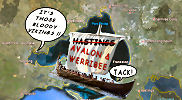 On November 6, 2012 it was reported that the Victorian government was cooling on the idea of another port for Hastings and instead its planners were casting their collective beady eye in the direction of Werribee. ("Government looks west for next port development," The Age, 6 Nov., p.6.) One imagines hope springing on the Mornington Peninsula as a dark shadow turns west to cast its pall on Werribeeans instead. But do we even need one new port?
On November 6, 2012 it was reported that the Victorian government was cooling on the idea of another port for Hastings and instead its planners were casting their collective beady eye in the direction of Werribee. ("Government looks west for next port development," The Age, 6 Nov., p.6.) One imagines hope springing on the Mornington Peninsula as a dark shadow turns west to cast its pall on Werribeeans instead. But do we even need one new port?
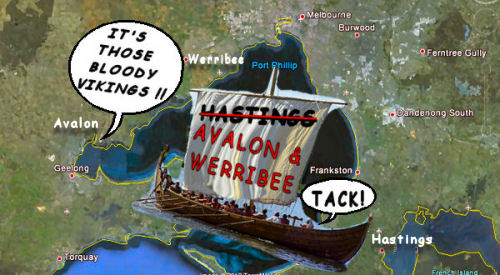
At first gasp, if you have lived down on the Mornington Peninsula under the threatening shadow of a planned port for Hastings, you might tentatively hope that the government has actually called the dogs off. Then, if you have some conscience, you might think, "But why inflict the same on Werribee?" The people who live in Werribee are our fellow citizens.
Werribee is, it is true, heavily industrialised, however the area also has extensive wetlands that nature relies on. Worse, there are documents indicating associated plans for even more elaborate destruction for the wider coastal area which is of historic cultural significance in Victorian hearts, bearing the evocative name of Avalon:
"Transport Minister Terry Mulder had been briefed on a proposed ''master plan'' for the Avalon region, including a container port, an international airport, industrial development and a formula one track."
The Absurdity of multiple ports
But why are we even thinking of another port? When did state governments begin to think in terms of serial ports, one after another, in preparation for a huge increase in container traffic against a real backdrop of container traffic decline. It seems insane, unless you consider the desperation that affects people accustomed to a certain income who see the prospects of maintaining their corporate and private empires declining in a world where growth is going to become impossible to maintain. Over the past few years such people have convinced governments to use taxpayers' money to finance huge infrastructure projects - like desalination plants and massive tollways - of questionable value but involving enormous turnover for those involved. Ports are just another version of the tollways, tunnels and city apartment blocks template for raising cash from banks, investors and taxpayers. The key is to make the project sound inevitable and necessary. That's their game and the growth merchants don't have another one.
Jenny Warfe, of Blue Wedges, says,
How many ports do we really need? We have a massive port in Melbourne – with another $1.5 billion expansion planned for soon, a substantial port in Geelong, and smaller ones in Portland and Hastings."
She reminds us that all these ports occupy important, formerly publicly owned coastal assets. Every one imposes considerable negative impacts on its surrounding suburbs and waterways.
With regard to 'heavily industrialised Werribee', the greater part of the Western shoreline is largely untouched.
"The area that is being talked about for the ‘Bay West’ port is an internationally significant RAMSAR site, on which rely millions of migratory birds every year, just like Westernport," Jenny reminds us.
Only in September, Jenny compered a lecture in Melbourne from visiting US academic Richard Heinberg, who is a well-known author on the problem of oil-depletion, which many think is behind the wars we are involved in in the Middle East. Oil production or extraction is no longer keeping up with the demands of compound growth in human economic activity. Even though there is oil out there, it is harder and harder to get out of the earth, with high risks for investors and the environment. Although there is an industry for recovering oil from tar sands and even shale, what the public lack the education to understand is that the cost of extracting oil from such forms hardly leaves room for any profit and is deadly for the environment. Decline in abundant, cheap oil availability means that there won't be any new sustained 'growth' in production, trade and transport of cheap goods round and round the world. The price of production goes up as the availability of easily accessible oil goes down, so production must adjust downwards.
"In his recent Melbourne address, Heinberg warned that as we reach peak oil and peak everything else, we may not be exporting and importing so much, and surely not so much of the low cost high volume junk that fills up so many import containers at the moment, " comments Ms Warfe.
(Although 'peak oil' indicates a peak of production, where there is more oil than at any other time, there is a cliff on the other side, and that is where we are heading. In fact there are many indications that we have passed that peak.)
"Mr. Heinberg is right to be adamant that we should focus on getting population expansion and consumption levels under control and power DOWN not UP, " she says.
Nutty idea to increase trade infrastructure when trade is in decline
This is the most important message of candobetter.net and Jenny joins the dots well. There is no point in building new ports for declining trade.
Jenny suggests that these ideas for more ports are coming from old fossils in suits blowing $billions on the tired old ‘business as usual’ pipe-dream- which is this latest port proposal in a nutshell.
Instead of more of the same with the public expected to lie down and think of England, while pipe-dream addicted planners rifle through the public purse, as Ms Warfe sums up:
"We need funds and good minds with the capacity to deal with reality. We need different solutions for the very different future we and all species on Earth face."
Yes, we don't need a new port in Hastings and we don't need a new port in Werribee. They are both bad ideas. A formula one car racing track in the Avalon Region, in the light of declining oil and the need to conserve energy, is sublimely ridiculous. One can only interpret this suggestion as symbolically associated with the awful and tragic dependence of the Australian economy on the automobile industry (which also enables the suburban development industry). For anyone who had never thought of this, try ... um... driving... round some outer suburbs and you will see entire districts dedicated, not only to the sale and maintenance of new and used cars, but to marketing and retailing a range of associated paraphernalia, from deodorisers to window transfers to car brand-name wind sheeters. This is the outcome of colonial corporate thinking and the suppression of diverse local manufacturing activity. Our politicians are responsible.
Peninsula Port Plans have already cost the community dearly
Unfortunately and absurdly, even if the Mornington Peninsula is reprieved from a huge industrial port sector at Hastings, the future traffic predicted to be associated with the Port was used as an excuse to put a huge new tollway, which already scars substantial landscape and bushland. Westerfield heritage area and large parts of The Pines have been destroyed to build that road in preparation for traffic to and from Hastings (port), over years of protest by environmentalists. Even agreements to fence off predators from bandicoot areas in the Pines have since been renegged on with the special sums allocated arbitrarily diverted to other projects by Parks Victoria, according to Hans Brunner.
But do the authors of these huge projects even care, as long as someone makes a profit along the line? Costs will be borne by any investors that were counting on guaranteed tollway profits due to hugely increased volumes of traffic on the Peninsula. Such schemes are money floats for those who initiate them, but the chances of them paying down the line with oil depletion looming are minute, and the designers almost certainly knew this. They were probably taking advantage of public ignorance of resource supplies. See SEITA tollway using old data on oil prices.
At no stage either is it ever made clear to the public how closely political parties of all hues are associated with such massive land-development projects, via their business and investment arms. For an idea of how this works, look at Labor Resources, bearing in mind that this kind of activity, although on a grand scale in the Labor Party, also goes on in the other established parties with big budgets and major landed and investment assets.
There is more to these port projects than meets the eye of the casual observer.





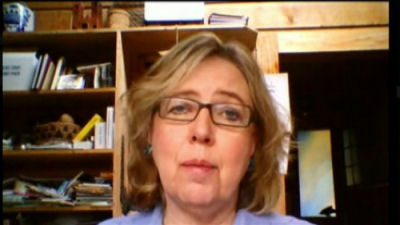
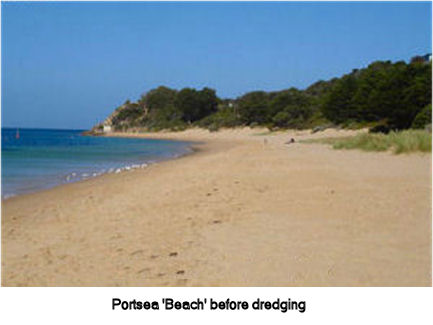
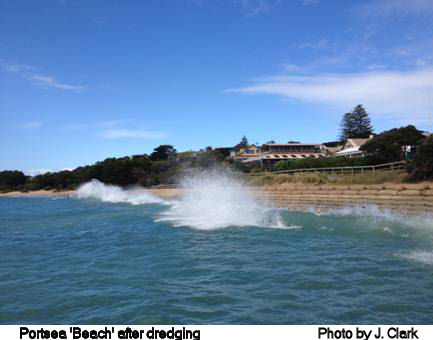
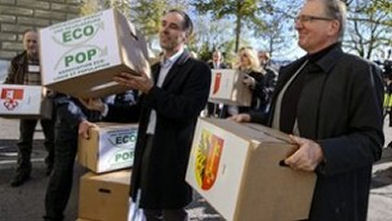
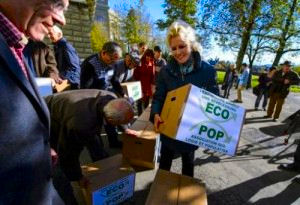
Recent comments